CLIMATE science for CHANGE
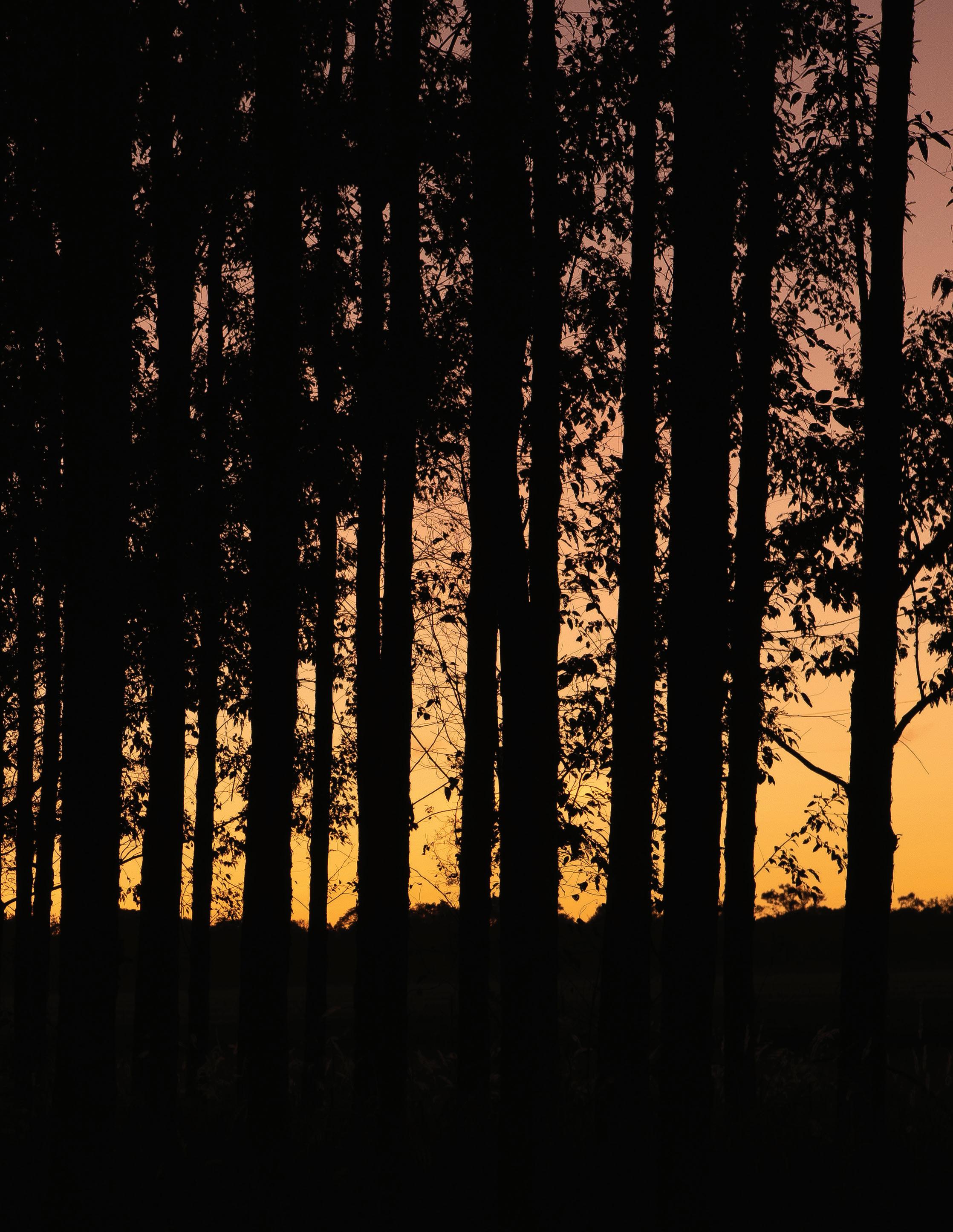
The forest line of defense
Forests protect us against a warmer climate—we have to protect them back
Is this the “new normal”?
What the climate impacts we’re already feeling can tell us about the future
Special section: 20 years at Tanguro
Two decades of rainforest research at the edge of the Amazon
SUMMER 2024
01 / From the President & CEO
03 / Updates and insights
05 / 2024 John Schade Memorial Scholars awarded
06 / After battle against cold, Polaris student Esmeralda Torres Martínez embraces her love of Arctic fieldwork
08 / Permafrost Pathways hosts Arctic youth, commemorates partnership with International Centre for Reindeer Husbandry
10 / The future of northern forests
11 / Global forest carbon storage, explained
13 / 2023 was a weird weather year, wasn’t it?
16 / 20 years at Tanguro Field Station
28 / New to Engineering? No Problem. Research Assistant Zoë Dietrich builds her own carbon-monitoring chambers
32 / Supporter profile | Larry Huntington

CLIMATE science for CHANGE
Climate Science for Change is published by Woodwell Climate Research Center in Falmouth, Massachusetts.
Woodwell Climate Research Center conducts science for solutions at the nexus of climate, people and nature. We partner with leaders and communities for just, meaningful impact to address the climate crisis.
PRESIDENT AND CEO
Dr. R. Max Holmes
CHIEF COMMUNICATIONS OFFICER
Dr. Heather M. H. Goldstone
SCIENCE WRITER AND EDITOR
Sarah Ruiz
DESIGN DIRECTOR
Julianne Waite
COPY EDITING
Margaret Lin
IMAGES
Zoë Dietrich, Abby Fennelly, Greg Fiske, Heidi Golden, Jonathan Kopeliovich, Mitch Korolev, Zander Nassikas, Brendan Rogers, Christina Shintani, Dee Sullivan/ MinFin Photography, Scott Zolkos
WOODWELL CLIMATE RESEARCH CENTER 149 Woods Hole Road Falmouth, MA 02540
Email: info@woodwellclimate.org
Website: woodwellclimate.org
COPYRIGHT
All material appearing in Climate Science for Change is copyrighted unless otherwise stated or it may rest with the provider of the supplied material. Climate Science for Change takes care to ensure information is correct at time of printing.
Woodwell Climate Research Center is located on the traditional and sacred land of the Wampanoag people who still occupy this land, and whose history, language, traditional ways of life, and culture continue to influence this vibrant community.
Contents
Nika Silverfox-Young shares the impacts of climate change in Alaska during morning introductions. / photo by Dee Sullivan/MinFin Photography
Dawn seen through eucalyptus trees at Tanguro Research Station in Mato Grasso, Brazil. / photo by Mitch Korolev
From R. Max Holmes, President & CEO

Any way you slice it, 2023 was a remarkable year for Earth’s climate.
Air and ocean temperatures shattered previous records, with warming in some months exceeding previous records by almost unimaginable margins. Heat waves, wildfires, floods, drought, and other climate extremes were depressingly commonplace, and lives and livelihoods were impacted across the globe. Every week seemed to bring a new disaster, a new headline, a new normal.
As 2023 unfolded and the magnitude of its warming became clearer, I began to wonder if something had fundamentally changed to account for the remarkable extremes. Yes, we had entered an El Niño phase, which tends to lead to warmer global temperatures, and cleaner shipping fuels required by recent international regulations could ironically also release additional warming. But the magnitude of the warming and its dramatic impacts led me, and many of my colleagues, to suspect that something else might be going on. Was it possible that the permafrost carbon feedback, which Woodwell scientists have studied for over a decade, had finally reached a tipping point? Or might Amazon forest dieback be unfolding, contributing additional carbon to the atmosphere? Somehow I just couldn’t accept that the remarkable warming we were seeing was “expected.”
Yet as 2024 progresses, more and more scientists are making the case that the seemingly anomalous warming of 2023 was exactly what we should have expected, and in fact was consistent with what climate models have been predicting for many years (page 13). I find myself being largely convinced by these arguments, which has created a dizzying array of competing emotions.
On the one hand, we could take comfort in the fact that we may have had the science right all along, that there wasn’t any unaccounted-for forcing that was pushing the climate to new extremes. But more fundamentally, it is cold comfort to have 2023’s extreme climate be the expected and unsurprising result of our failure to take aggressive action to slow climate change over the past years and decades. If we knew this was coming, how could we possibly have let it happen?
And yet here we are. Over the coming months, scientists will tease apart all the drivers of 2023’s remarkable warming, but what is abundantly clear is that human actions are the dominant drivers and only human actions will be able to reverse course in the future.
That, fundamentally, is the work of Woodwell Climate Research Center—putting the brakes on climate change by conducting science for solutions at the nexus of climate, people, and nature. This work has never been more urgent, more essential for achieving a sustainable future.
Each month, we see evidence of the impact our work is having (page 4). Each year, we are able to advance innovative ideas (page 2) and support the careers of aspiring new climate champions (page 5). And, once in a while, we get to celebrate a milestone for a project with a legacy and bright future of work that embodies “science for solutions.” This year marks the twentieth anniversary of Tanguro Field Station (page 16)—a unique, natural laboratory at the edge of the Amazon agricultural frontier that is at the heart of much of our work on balancing food and forests.
Thank you for being part of the Woodwell team. Thank you for making our essential work possible. Onward.

Summer 2024 1 Climate Science for Change
Fund for Climate Solutions awards five new grants
From the Arctic to the tropics, the 2024 winter cohort of FCS projects fills information gaps with actionable insights
The first round of 2024 Fund for Climate Solutions (FCS) awardees has been announced. The FCS advances innovative, solutions-oriented climate science through a competitive, internal, and cross-disciplinary funding process. Generous donor support has enabled us to raise more than $10 million towards the FCS, funding 63 research grants since 2018. The latest cohort of grantees includes five projects addressing key information gaps in climate science to produce actionable insights, from quantifying understudied carbon emissions in the Arctic and the Amazon to predicting drought in the Democratic Republic of Congo.

Quantifying
large greenhouse gas emissions from a retrogressive thaw slump in Alaska
Project lead: Dr. Jennifer Watts
Collaborators: Dr. Kyle Arndt, Patrick Murphy
Retrogressive thaw slumps (RTS) are extreme permafrost thaw landscape features, which occur when a section of ice-rich permafrost becomes warm enough to cause the ground ice to melt and soils to collapse. Once they start, RTS continue to expand and destroy nearby permafrost for months to years. Many RTS have been identified, but because they are often in extremely remote Arctic locations, very little is known about the potentially substantial carbon emissions from RTS in the form of carbon dioxide and methane. This study will provide the first continuous measurements of carbon emissions from a RTS, collected over at least a year via an eddy covariance tower. The research is also supported by an equipment loan provided through the U.S. Department of Energy AmeriFlux Rapid Response program, which recognized this project as a valuable opportunity to advance science. The data collected will also serve as a “proof of concept” for a subsequent $1.3M proposal to the National Science Foundation for continued research at the site.

Assessing the impacts of ecosystem disturbance on carbon emissions from Arctic and Amazon ponds
Project lead: Dr. Elchin Jafarov
Collaborators: Zoë Dietrich, Andrew Mullen, Dr. Jackie Hung, Dr. Marcia Macedo, Kathleen Savage
Freshwater ecosystems are significant sources of the greenhouse gases that persist in the atmosphere and contribute to warming. However, research is lacking an understanding of how disturbances like wildfire and agriculture can change these emissions. This project will address these information gaps by collecting measurements of carbon emissions from ponds using autonomous floating chambers developed with funding from a previous FCS grant. With this new high-resolution data, the team will unlock the ability to predict year-round greenhouse gas emissions from ponds in the Arctic and the Amazon. Floating chambers will be deployed in ponds in Alaska affected by wildfires, and in agricultural reservoirs in the Amazon-Cerrado frontier. In both locations, the ability to take more frequent measurements of carbon emissions will help researchers improve models and better assess the ponds’ impacts on regional carbon budgets.
Updates and insights
A retrogressive thaw slump in Canada’s Northwest Territories. / photo by Scott Zolkos
Summer 2024 Climate Science for Change 2
Dr. Marcia Macedo samples water at Tanguro Research Station in Brazil. / photo by Mitch Korolev

Determining the climate sensitivity of coastal rivers to guide ecosystem restoration across Southeastern Massachusetts
Project lead: Dr. Abra Atwood
Collaborators: Dr. Marcia Macedo, Dr. Chris Neill, Dr. Linda Deegan, Dr. Scott Zolkos
Coastal rivers, like those that flow into Massachusetts’ Buzzards Bay and Vineyard Sound, are fragile environments that serve critical ecological functions for native fish, downstream estuaries, and coastal wetlands. Different rivers are uniquely sensitive to changes in air temperature based on a variety of characteristics, such as their water source or shade. However, land use changes, including housing development and cranberry bogs, have affected key river characteristics and stream temperatures. This project will investigate MA coastal rivers’ sensitivity to changing air temperature, as well as how that sensitivity is affected by both connection to groundwater and the creation or restoration of cranberry bogs. The temperature sensors and geochemical analyses used in this research may be scalable beyond these rivers and yield insights to inform research approaches relevant to rivers around the world.

The Polaris Project: Data synthesis from almost two decades of research and student participation
Project lead: Dr. Nigel Golden
Collaborator: Dr. Sue Natali
Established in 2008, the Polaris Project has earned global recognition for its leadership in Arctic research, education, and outreach. Through the commitment to providing students with hands-on experience, Polaris has enabled numerous
A team samples the Santuit River in Massachusetts. /
Dr. Nigel
publications and presentations. Polaris is approaching a critical juncture in the next funding cycle, and this project will complete the first-ever comprehensive synthesis of Polaris Project research to help sustain Woodwell Climate’s sole undergraduate research program. By consolidating past research and educational achievements, the team will create a data synthesis paper to be submitted to a peerreviewed, open-access scientific research journal, as well as a retrospective analysis of undergraduates’ research experiences with Polaris to be submitted to an education research journal. The team will also launch an online communications piece that documents past Polaris participants’ field experiences and unique journeys with a variety of narrative and artistic communications styles and elements.

A drought early warning system for the DRC: Developing a seasonal forecast based on novel machine learning approaches
Project lead: Dr. Carlos Dobler-Morales
Collaborators: Dr. Christopher Schwalm, Dr. Glenn Bush
Seasonal weather forecasts hold immense potential to improve risk management from agricultural failure, water stress, and extreme events. However, significant advances in technical forecasting capabilities remain largely unavailable to communities without the resources to develop or customize them for their region. In 2023, Woodwell Climate Just Access co-produced a national climate risk assessment with the Democratic Republic of Congo’s Ministry of Environment and Sustainable Development. That report identified drought as a major climate threat to the DRC—one which stands to affect almost the entire country. In response, this project will develop a seasonal drought forecasting model tailored to the DRC using cutting-edge machinelearning methods. The forecast will be able to deliver precise rainfall anomaly predictions up to six months in advance for the whole country, and serve as an early warning system to help local people and decision-makers anticipate the impacts of escalating drought risk.
the field with the 2023 Polaris Project team in Alaska’s Yukon-Kuskokwim Delta. / photo by Heidi Golden Woodwell Climate hosts a workshop with the DRC’s Ministry of Environment and Sustainable Development. / photo by Abby Fennelly
photo by Zander Nassikas
Golden in
Summer 2024 3 Climate Science for Change
Impact updates


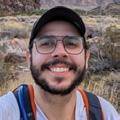








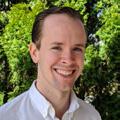







By the numbers
JANUARY
Fifteen Google.org Fellows kick off a six-month engagement with Permafrost Discovery Gateway, significantly expanding the software development team and accelerating efforts to integrate new datasets and AI tools and upgrade the platform’s user interface.
https://woodwellclimate.org/permafrost-discovery-gateway-google-fellows
FEBRUARY
Dr. Ludmila Rattis’s TED Talk, “How poop turns into forests,” is released and viewed more than 400,000 times in the first two months. Dr. Rattis, Woodwell Climate’s second TED speaker, is an Assistant Scientist in the Tropics program and Tanguro Field Station General Coordinator.
https://woodwellclimate.org/how-poop-turns-into-forests
MARCH
Scientists from Woodwell Climate Research Center join nearly 200 other leading experts in forest ecosystems, climate change, and the carbon cycle in urging the Biden Administration to immediately declare a moratorium on all logging in mature and old-growth forests on federal lands.
https://woodwellclimate.org/ban-logging-federal-mature-forests
APRIL
Senior Scientist Dr. Jen Francis is quoted in an AP News article about March being the tenth consecutive month to break heat records, and that story is syndicated more than 500 times. Similarly, Dr. Francis was quoted in a widely-syndicated January AP News story about 2023’s record heat.
https://bit.ly/apnews-heat-record
MAY
In Flux, an exhibition of diverse artwork responding to rapid Arctic change created by five Woodwell-affiliated artists, opens at Highfield Hall and Gardens in Falmouth, MA. The exhibition runs through mid-July.
https://bit.ly/in-flux-exhibit
INSIGHTS FROM RECENT WOODWELL CLIMATE PUBLICATIONS
Fire-induced tree mortality in Siberian larch forests
https://doi.org/10.1029/2023GL105216
Overestimation of carbon dioxide absorption by Arctic ecosystems when models assume landscape homogeneity
https://doi.org/10.5194/bg-21-1301-2024
Updates and insights continued
Jasmina Tomic / TED
83
2
Summer 2024 Climate Science for Change 4
% X
2024 John Schade Memorial Scholars awarded Fund
supports Polaris students’ graduate careers
Sarah Ruiz Science Writer and Editor
Two new Polaris Project Alumni have been named John Schade Memorial Scholarship recipients. The fund, established in the memory of Dr. John Schade, who founded Polaris and was integral to its success, is dedicated to supporting the higher education goals of students that reflect Dr. Schade’s values of mentorship, education, leadership, equity, and the advancement of Arctic science.
Both recipients will receive funding to continue their education and pursuit of science, mentorship, and equity, encouraging a new generation of Arctic scientists working to change the world.

Mandala Pham
Mandala Pham studies geophysics and history at the University of Texas at Austin. As an undergraduate researcher, she has explored the caves of central Texas, studied marine geophysics in Corpus Christi Bay, and peered back in time to past climates through geology. Her experience in different lab groups spurred her interest in field work, driving her to pursue graduate opportunities to continue getting up close with geology.
During her Polaris experience, however, Pham’s research focused less on geology and more on ecology. Inspired by her father’s affinity for beautiful, rare, and sometimes poisonous mushrooms, Pham studied the response of Arctic mushroom species to wildfire, comparing biodiversity between burned and unburned areas of land.
As part of Polaris, Pham saw a glacier in person for the first time, which reinforced her commitment to dedicate her career to studying and fighting climate change.
“From childhood anxieties to professional aspirations, I’ve taken tackling climate change as my personal direction in life,” says Pham. “I want to be part of the solution rather than spending my time ruminating on the worst-case scenarios.”
She hopes to get her Ph.D. in geophysics, studying glaciology. After that, she has aspirations for either full time research or a career in the National Park Services. Pham is also interested in screenwriting, pig farming, and perhaps one day, becoming a lighthouse keeper.

Aaron MacDonald
Aaron MacDonald’s passion for ecology began during his childhood spent on long family camping trips. Through his studies at University of Toronto, MacDonald has gained experience in oceanography and fisheries science through the Woods Hole Partnership Education Program (PEP) and the National Oceanic and Atmospheric Administration (NOAA) Inclusive Fisheries Internship. His field experience bolstered his confidence to pursue a scientific career.
With Polaris, MacDonald studied the role of willow ptarmigan, a common Arctic ground bird, as a driver of ecosystem dynamics on the tundra. For his career, he hopes to pursue a graduate degree and get involved with mentorship programs like Polaris. MacDonald firmly believes everyone should have the opportunity to study science, and is grateful for the support he received that has allowed him to pursue this career.
“Everyone who wants to is capable of scientific research and everyone has a place in STEM,” says MacDonald. “I have questioned many times if there is a place for me in STEM, but with the support of those around me I am determined to make it.”
In his spare time, MacDonald enjoys running and video games with friends.
Summer 2024 5 Climate Science for Change
In my own voice: Esmerelda Torres Martínez
After battle against cold, Polaris student Esmeralda Torres
Martínez embraces her love of Arctic fieldwork
I am a woman who lives for adventure, mud, and heat. The Caribbean sunshine, warmth, and humidity of my island, Borikén, hug me every single day. That’s why many people find it strange that in the summer of 2022, I ended up on the other side of the world from my Carribean island home, willingly experiencing freezing temperatures.
So, here’s my story: I grew up in Puerto Rico, a couple of Caribbean islands that are very vulnerable to the effects of climate change. The burning of fossil fuels and the destruction of forests are causing Arctic ice to melt which, in addition to affecting the climate of the planet, is affecting Boriké. Rising sea levels, more frequent and stronger hurricanes, and constant landslides are some of the dangers I am already experiencing on my island.
Although I do a lot of environmental work there, a few years ago I decided to visit the Arctic to fully understand how climate change is also affecting other types of ecosystems. Because climate change is a global phenomenon, I sought to learn how to properly support and collaborate with other at-risk communities outside of the boundaries of my islands, even if that meant stepping outside my comfort zone in another part of the world.
The problem was, I’d never lived in polar temperatures. I’ve hiked hundreds of miles of coastal and humid tropical forests to conduct research, yet visualizing myself as an Arctic scientist in an environment so different was nearly impossible.
But as I said before, I am a woman who lives for adventure, so if I was going to experience a new environment I was going to get the full experience.
So that summer I packed up my giant backpack and joined eight other young researchers for Woodwell Climate’s Polaris Project—a two-week long research trip in the Yukon-Kuskokwim Delta of Alaska. Polaris gives students the chance to design their own studies and gain experience conducting Arctic research. It was with Polaris that my battle against the cold began.
I spent my time in remote areas of the Tundra, a carbon-rich ecosystem lacking mountains and trees, yet full of life and history. I had to live in a tent to conduct my research on how the groundwater system is changing. My usual day in the Arctic


6
looked like lots of hiking in the mud, carrying pipes and drills in my backpack, wearing mosquito nets, and taking water and soil samples in temperatures as low as 48 degrees Fahrenheit. Although 48 degrees might not be cold for many folks on Turtle Island—the original name for North America —as someone from the Caribbean, anything below 70 degrees is already too cold to handle.
Add onto that the rainy days, the lack of access to communications, internet, electricity, and water service. Needless to say, my first experience with cold was an intense one.
But you know what? I loved it.
I loved working with new friends, colleagues, and mentors. I loved getting to know the Yup’ik and Cup’ik communities guarding these lands. I loved doing science projects that served a common good.
I loved fieldwork in the cold.
However, when I went back home and felt that rich Caribbean sunshine and heat again, I began questioning myself.
How could I have enjoyed working in the cold? Could I really be a scientist in the Arctic even though I didn’t grow up in the Arctic? My Polaris experience lasted only two weeks, and they were the most challenging two weeks of my entire career. Could I endure weeks, months, or even years in these conditions?
Would I let the cold win this battle?
Well, I would have to face the cold one more time either way. Polaris students present the results of their research each year at the American Geophysical Union conference in December. To give my research presentation, I had to travel to Chicago—in the middle of winter.
Have you ever felt the chilling winds of Chicago? It’s known as the windy city for crying out loud! I guess it was time for me to get back to the battlefield.
I packed all my coats, got on a plane, touched down in traditional Potawatomi lands, and tried not to freeze to death.
walking to the convention center, going over in my mind the speech I had to give, I felt the most chilling cold I had ever experienced in my life. When I looked down at my feet, I realized that I had packed the wrong shoes! In thin flats, my feet were totally exposed.
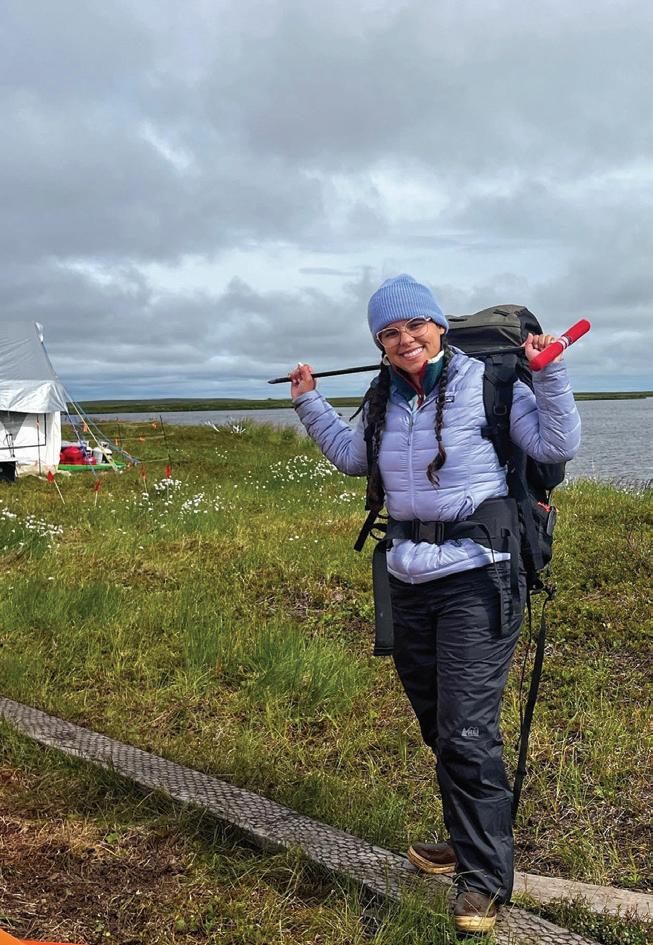

The wind and snow was strong the day I had to present my research. It was actually my first time experiencing snow falling from the sky, so I bundled up warmly. But as I was
This was the moment you might conclude that the cold finally beat me. Yet, when I looked back down at my exposed feet, I just couldn’t stop laughing.
After so much effort to “win the battle,” at that very moment I realized the battle doesn’t exist. There is no battle against the cold.
Living in the cold is a lifestyle like any other. Just as my ancestors taught me how to live in harmony with the tropical climate, there are entire communities that apply their millennia-old knowledge to live in harmony with polar temperatures, and in fact depend on it to keep the ground they are built on from thawing and collapsing.
It wasn’t until that moment in Potawatomi lands that I fully realized how much I loved working in Yupi’k and Cupi’k lands. I learned that, whether it’s in the Arctic or in the Caribbean, to become a responsible scientist I need to rethink and rework my perspective and relationship with the land.
Valuing and protecting cold lands, using guidance from the communities that live there, is critical to maintaining a stable climate. For me, embracing the cold gave me a strong step towards stopping climate change.
Hiking in El Yunque National Forest, Puerto Rico. / photos courtesy of Esme Torres Martínez
Summer 2024 7 Climate Science for Change
Helicopter view of the Polaris Project campsite. All geared up and ready to leave camp for field work.
In Chicago at the American Geophysical Union conference in December. Notice the shoes!
Permafrost Pathways hosts Arctic youth, commemorates partnership with International Centre for Reindeer Husbandry
Partners celebrated new collaboration with special day of Arctic programming
Jessica Howard Arctic Communications Specialist
As part of a new partnership between Permafrost Pathways and the International Centre for Reindeer Husbandry (ICR), the Arctic Initiative at Harvard Kennedy School and Woodwell Climate Research Center hosted 18 Indigenous youth from across the circumpolar North for a day of science, mapping, storytelling, and policy programming. Woodwell Climate Senior Scientist and Permafrost Pathways Lead Dr. Sue Natali signed a formal memorandum of understanding (MOU) with ICR Executive Director Anders Oskal and Woodwell Climate President Dr. Max Holmes establishing a new relationship focused on climate change and Arctic resilience.
Arctic Indigenous youth cohort visit Woodwell Climate
The event was part of the Arctic Innovation Lab—a program that builds capacity among younger generations, uplifts youth voices, and facilitates discussions focused on developing solutions to climate change in the Arctic. In partnership with the Arctic Initiative, the lab is a facet of the global GEF-UNEP Reindeer Herding and Resilience project led by ICR’s Dr. Prof. Svein D. Mathiesen and Project Coordinator Marina Tonkopeeva, and the UArctic EÁLAT Institute. Oskal, Tonkopeeva, and the Arctic Innovation Lab’s third youth cohort visited the Woodwell Climate campus to participate in a variety of thematic sessions, beginning with an overview of how Arctic change caused by permafrost thaw and boreal fires is impacting communities, infrastructure, and natural ecosystems.
Other programming included presentations about the global importance of Arctic warming and how to leverage tools like mapping to both illustrate change in the Arctic and to effectively communicate the urgent need for solutions to policymakers. Indigenous youth leaders from Mongolia, Finland, Sweden, Norway, Russia, Canada, and Alaska shared unique stories about life in the north and described
the changes they’re experiencing caused by climate change, development, and government policies that are collectively threatening their traditional ways of life.
Preserving traditional reindeer husbandry
Today, about 100,000 people across nine countries participate in reindeer herding with about 2.5 million semi-domesticated reindeer. Reindeer herding peoples, such as the Sámi, have practiced subsistence ways of living across the Arctic region since time immemorial. The intimate relationship between reindeer and Sámi people is one of ancient origin that transcends practicality alone—their health, well-being, and futures are mutually dependent on one another.
But reindeer and reindeer herders face profound challenges as they grapple with pasture loss, the intrusion of extractive industries, and the impacts of Arctic climate change such as permafrost thaw and land degradation. Reindeer husbandry is forced to adapt to these threats while trying to maintain their traditional lifeways. Stewarding the preservation of this centuries-old knowledge and culture is one of the many responsibilities of ICR.
Founded in 2004, ICR is the organizing body responsible for enhancing global understanding of reindeer husbandry and reindeer herding peoples, their traditional knowledge, and how their cultural practices will be sustained in an increasingly warming climate. By establishing interdisciplinary cooperation amongst reindeer herders, research and academic institutions, industry, and international governments, ICR continues to work toward a sustainable and resilient future for circumpolar reindeer husbandry.
A collaborative effort towards a resilient future
Permafrost Pathways first began working with ICR in August 2023 during a workshop at the Arendalsuka Political Gathering
Summer 2024 Climate Science for Change 8
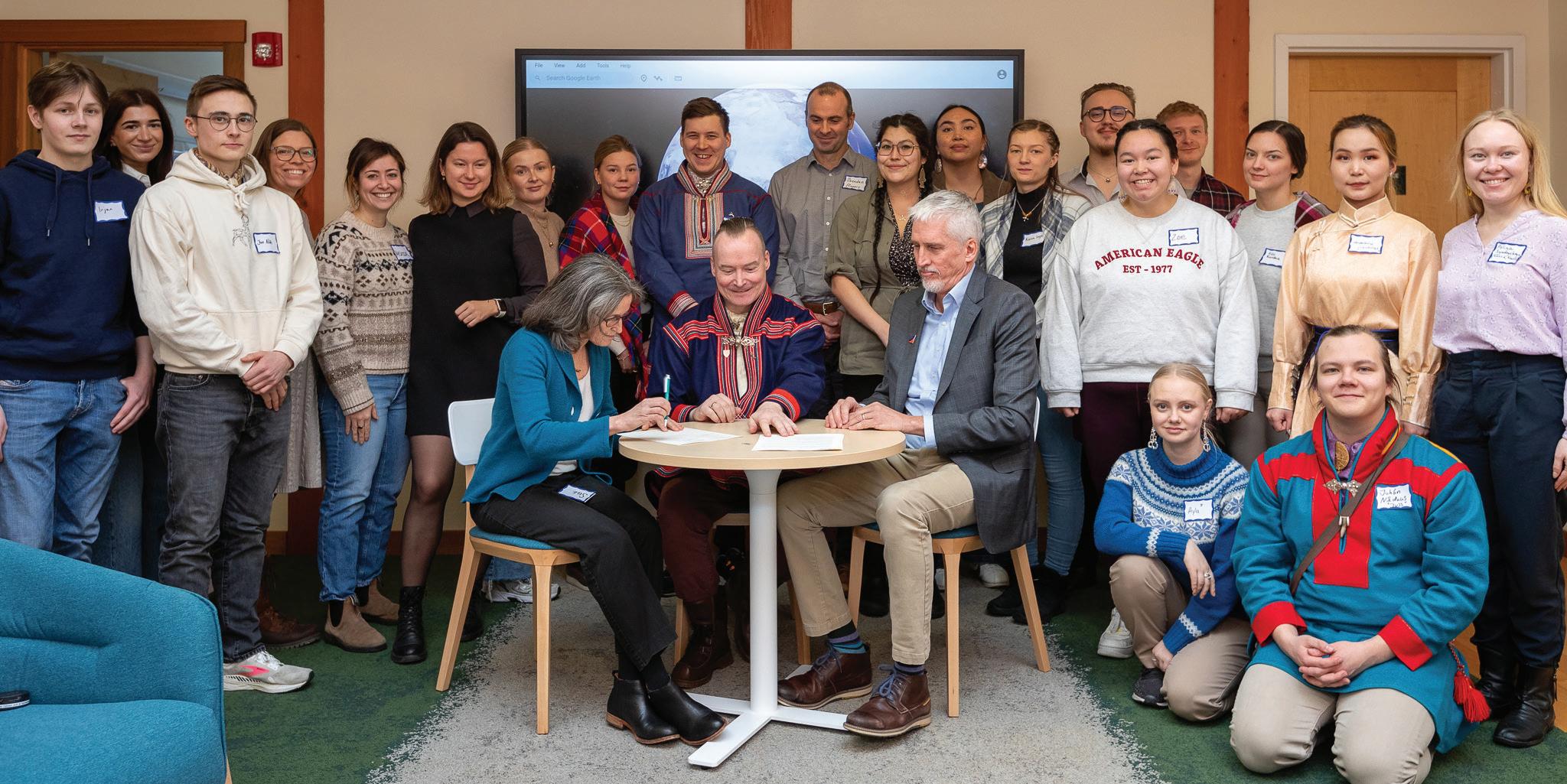
in Norway. The week-long workshop organized by ICR focused on enhancing Arctic resilience and addressing land degradation and permafrost thaw through Indigenous youth empowerment, creating a dedicated space for youth voices to be heard and build the necessary leadership and policy skills to actively influence legislation.
Permafrost Pathways partners and ICR will be co-producing maps of land use and landscape change while co-designing GIS
training courses for Indigenous youth in Norway and Mongolia with the common goal of supporting community-led solutions to land degradation in the Arctic. The Permafrost Pathways policy and communications teams are also working closely with ICR to expand collaborative programming at upcoming events and workshops to support youth empowerment and advance adaptation, resilience, and intergenerational justice in the Arctic.
Arctic Indigenous youth leaders gather with Arctic Initiative, Woodwell Climate, and ICR staff as the memorandum of understanding is signed. / photos by Dee Sullivan/MinFin Photography
Reindeer husbandry lands (hatched area) span much of the permafrost region (blue shading) across Eurasia. / map by Greg Fiske

Summer 2024 9 Climate Science for Change
The future of N orth e r n Fo r e s t s
How will North America’s forests change in the coming decade? Recent research from Woodwell Climate scientists Dr. Arden Burell, Sol Cooperdock Stefano Potter, and Dr. Brendan Rogers, uses machine learning methods and data from 25,000 forest sites across the U.S. and Canada to start answering that question. By creating near-term predictions of changes in aboveground biomass (AGB) in boreal and northern temperate forests, researchers were able to show that the future of these forests will vary by region. Most forests were predicted to gain biomass, as expected under a stable climate until a disturbance such as wildfire resets growth. However, boreal forests at the dry end of the biome’s range, particularly those dominated by black spruce, are at greater risk of tree mortality due to climate change and losing AGB as temperatures rise over the n and likely signals the early stages of a northward boreal biome shift. ext few decades. This means fewer trees—and less carbon on the landscape,
Predicted change in aboveground biomass by 2030
Decreases in AGB are seen in areas that are susceptible to drought and have shown early warning signals of tree mortality from remotely sensed imagery
Seeing Green
Increases in AGB are seen in younger tree stands and faster-growing temperate forests.
What will northern forests look like in 2030?
Nearly 25% of forest sites were modeled to lose aboveground biomass by 2030, largely because of drought. Climate change induced tree mortality will shift the boreal forest biome north.
How Models Work
Machine learning models are generally better at predicting gains in AGB than losses, but researchers used an assemblage of multiple models to improve the accuracy of their predictions for this study. Availability of sampling location data also influences model outcomes Roughly half of forest sites were located in the boreal region—increasing data collection in a broader range of northern forests could expand predictions of the extent of biomass losses.


Temperate forests show increases in AGB. Many of these forests are managed for timber, made up of fast-growing younger trees that add biomass quickly on a short time scale but ultimately store less carbon than mature and old-growth forests.
Boreal
Forest Loss
A majority of the predicted AGB losses occur in boreal forests, where warmer temperatures and droughtinduced tree mortality could push this system northwards



Refuge in the East Wetter regions will be more resilient to temperature changes Eastern Canada has the potential to become a “climate refuge ”





L a b ra d o r S e a AT L A N T I C OCE A N PA C I OC E Be a ufort S e a
Data: Burrell et al. 2024. “The Predictability of Near-Term Forest Biomass Change in Boreal North America.” Ecosphere 15(1): e4737. https://doi.org/10.1002/ecs2.4737; RESOLVE Ecoregions 2017. Map: Christina Shintani
Global forest carbon storage, explained
Protecting forests is one of our best climate solutions. Here’s how forests around the world store carbon.

When it comes to reversing climate change, trees are a big deal. Globally, forests absorb nearly 16 billion metric tonnes of carbon dioxide per year, and currently hold 861 gigatonnes of carbon in their branches, leaves, roots, and soils. This makes them a valuable global carbon sink, and makes preserving and maintaining healthy forests a vital strategy in combating climate change.
But not every forest absorbs and stores carbon in the same way, and the threats facing each are complex. A nuanced understanding of how carbon moves through forest ecosystems helps us build better strategies to protect them. Here’s how the world’s different forests help keep the world cool, and how we can help keep them standing.
Tropical forest carbon
Tropical rainforests are models of forest productivity. Trees use carbon in the process of photosynthesis, integrating it into their trunks, branches, leaves, and roots. When part or all of a tree dies and falls to the ground, it is consumed by microorganisms and carbon is released in the process of decay. In the heat and humidity of the tropics, vegetation grows so rapidly that decaying organic matter is almost immediately reincorporated into new growth. Nearly all the carbon stored in tropical forests exists within the plants growing aboveground.
Studies estimate that tropical forests alone are responsible for holding back more than 1 degree C of atmospheric warming. 75% of that is due simply to the amount of carbon they store. The other 25% comes from the cooling effects of shading,
Flooded lowland rainforest in Brazil. / photo by Mitch Korolev
pumping water into the atmosphere and creating clouds, and disrupting airflow.
In many tropical forest regions, there is a tension between forests and agricultural expansion. In the Amazon rainforest, land grabbing for commodity uses like cattle ranching or soy farming has advanced deforestation. Increasing protected forest areas and strengthening the rights of Indigenous communities to manage their own territories has proven effective at reducing deforestation and its associated emissions in Brazil. “Undesignated lands” have the highest levels of land grabbing and deforestation.
Fire has also become a growing threat to the Amazon in recent years, used as a tool to clear land by people illegally deforesting. When rainforests have been fragmented and degraded, their edges become drier and more susceptible to out-of-control burning, which weakens the forest even further. Enforcing and strengthening existing anti-deforestation laws are crucial to reduce carbon losses.
In Africa’s Congo rainforest, clearing is usually for small subsistence farms which, in aggregate, have a large effect on forest loss and degradation. Mobilizing finance to scale up agricultural intensification efforts and rural enterprise within communities, while implementing protection measures, can help decrease the rate of forest destruction. Forests and other intact natural landscapes such as wetlands and peatlands could be the focus of climate finance mechanisms that encourage sustainable landscape management initiatives.
Summer 2024 11 Climate Science for Change
Sarah Ruiz Science Writer and Editor
Temperate forest carbon
Much of the forest carbon in the temperate zone is stored in the trees as well—particularly in areas where high rainfall supports the growth of dense forests that are resilient against disturbances like drought or disease. The temperate rainforests of the Northwestern United States, Chile, Australia, and New Zealand contain some of the largest and oldest trees in the world.
Two thirds of the total carbon sink in temperate forests can be attributed to the annual increase in “live biomass,” or the yearly growth of living trees within the forest. This makes the protection of mature and old-growth temperate forests paramount, since older forests add more carbon per year than younger ones and have much larger carbon stocks. Timber harvesting represents one of the most significant risks to the carbon stocks in temperate forests, particularly in the United States where 76% of mature and old growth forests go unprotected from logging. Fire and insects are also significant threats to temperate forests, particularly in areas of low rainfall or periodic drought.
Maintaining the temperate forest sink means reducing the area of logging, both by removing the incentive to manage public forests for economic uses and by providing private forest owners with incentives to protect their land. Lowimpact harvesting practices and better recycling of wood products can also help bring down carbon losses from temperate forests. In areas threatened by increasingly severe wildfires, reducing fuel loads—especially near settlements— can help protect lives and property.

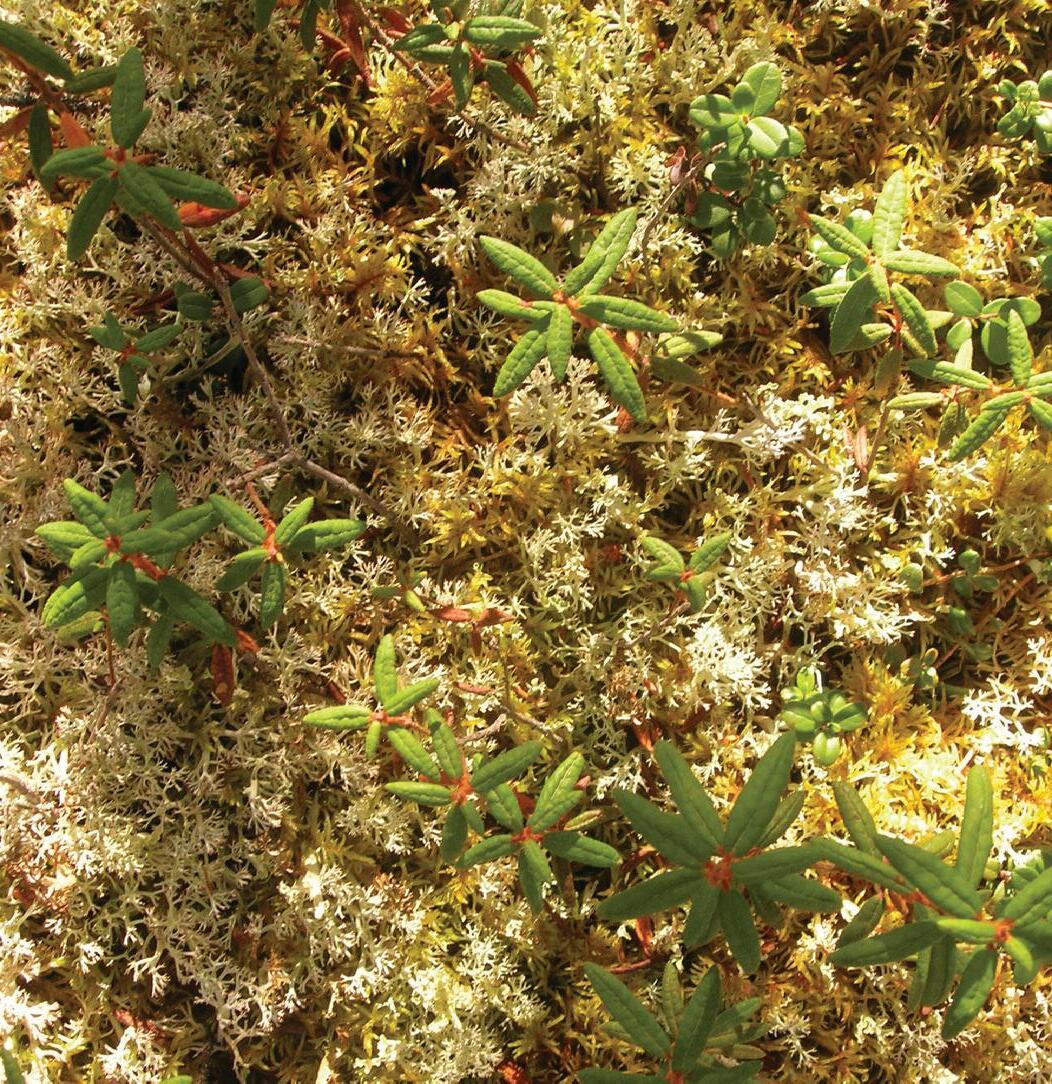
forest carbon
In boreal forests, the real wealth of carbon is below the ground. In colder climates, the processes of decay that result in emissions tend to lag behind the process of photosynthesis which locks away carbon in organic matter. Over millennia, that imbalance has slowly built up a massive carbon pool in boreal soils. Decay is even further slowed in areas of permafrost, where the ground stays frozen nearly year round. It estimated that 80 to 90% of all carbon in boreal forests is stored belowground. The aboveground forest helps to protect belowground carbon from warming, thaw, decay, and erosion.
Wildfire—although a natural element in boreal forests— represents one of the greatest threats to boreal forest carbon. With increased temperatures, rising more than twice as fast in boreal forests compared to lower latitudes, and more frequent and long-lasting droughts, boreal forests are now experiencing more frequent and intense wildfires. The hotter and more often a stand of boreal forest catches fire, the deeper into the soil carbon pool the fire will burn, sending centuries-old carbon up in smoke in an instant. Logging of high-carbon primary forests is also a big issue in the boreal.
The number one protection for boreal forest carbon is reducing fossil fuel emissions. Only reversing climate change will bring boreal fires back to the historical levels these forests evolved with. In the meantime, active fire management in boreal forests offers a cost-effective strategy to reduce emissions—studies found it could cost less than 13 dollars per ton of carbon dioxide emissions avoided. Strategies for fire management included both putting out fires that threaten large emissions, and controlled and cultural burning outside of the fire season to reduce the flammability of the landscape.
Boreal
A closer view of a boreal forest floor. / photo by Brendan Rogers Forest cleared for timber harvest in Howland Forest, Maine. / photo by Jonathan Kopeliovich
12
2023 was a weird weather year, wasn’t it?
Climate scientists weigh in on what 2023’s record-breaking temperatures say about climate models
Sarah Ruiz Science Writer and Editor
We can all agree 2023 was a weird year for weather, right? The United States set a record for the number of billion dollar weather disasters. A major Amazon River tributary reached its lowest water levels in a century during extreme drought. Extreme rain in Libya caused two dams to break, destroying homes and killing over 4,000 people.
And then, of course, there was the heat. 2023 was the hottest year on record. Countries around the world saw heat records fall month after month. The Arctic was hot. The ocean was hot. And debates swirl on about whether we’ve already passed critical warming thresholds.
So how do we put 2023 in context of the greater trend of warming? Here’s what some of Woodwell Climate’s scientists have to say about last year’s record-breaking events.
Did the models predict this?
The dramatic scenes of heat and extreme weather last year prompted many to ask why temperatures had seemingly spiked way above the trend line. Was this unexpected? Was it out of the range of what scientists had modeled? Woodwell Senior Scientist Dr. Jennifer Francis says not entirely.
“Almost exactly a year ago,” says Francis, “we had just come out of three years of La Niñas and we came close to breaking global temperature records then, even though La Niñas tend to be cooler than neutral or El Niño years. And then along came the strong El Niño of 2023.”
El Niño and La Niña are two extremes of a natural phenomenon that impacts weather patterns across the Pacific, and around
the world. In an El Niño year, the prevailing trade winds that normally push warmer waters into the western tropical Pacific—allowing cooler water to well up along the western coast of the Americas—are reversed, resulting in hotter ocean surface temperatures in the eastern equatorial Pacific. When the ocean is hotter than the air above it, that heat is released into the atmosphere, often making El Niño years record-breaking ones for global temperatures.
“Last year’s spike looks a lot like the last big El Niño event in 2015–2016. It’s just that now the whole system is warmer. So to me, it wasn’t at all a surprise that we smashed the global temperature record in 2023,” says Francis.
Hurricane Idalia in August 2023 flooded much of the city of St. Petersburg, FL. Meteorologists are concerned about the potential for destructive hurricanes in 2024. / photo courtesy of the City of St. Petersburg/Flickr
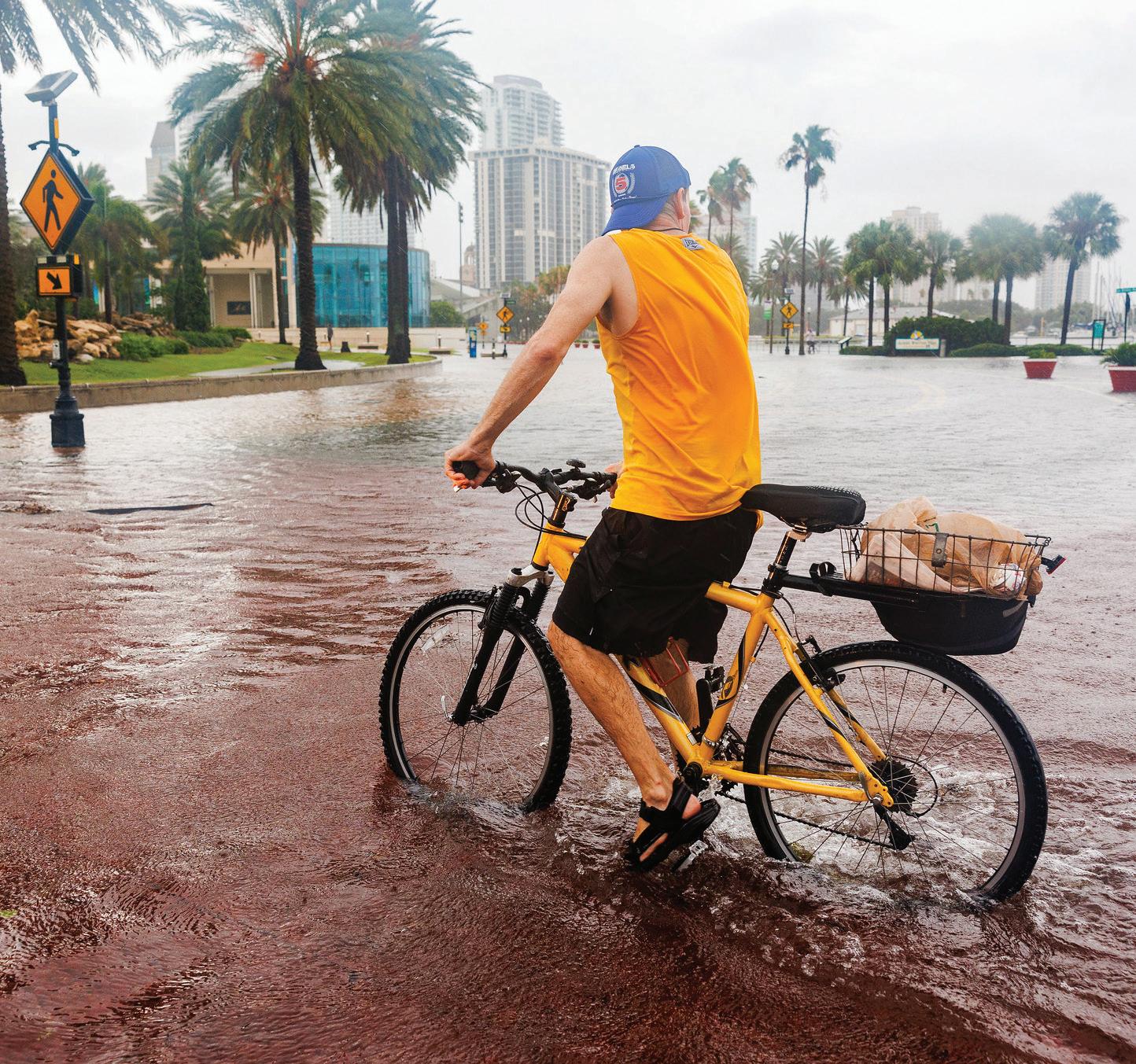
Summer 2024 13 Climate Science for Change
The spike put global temperatures far above the average of climate model simulations, but that doesn’t mean the models didn’t account for it. Risk Program Associate Director Dr. Zach Zobel, says that averages tend to smooth out natural year-toyear fluctuations, when in fact the upper and lower ranges of model predictions do encompass temperatures like the ones seen in 2023.
“It was well within the margin of error that you would expect for natural variations,” says Zobel.
How does ocean heat impact the climate?
One element of last year’s heat, one that wasn’t necessarily forecasted, was the simultaneous appearance of several ocean heat waves around the globe. The ocean absorbs the vast majority of heat trapped by greenhouse gasses, and that heat can be released under the right conditions. El Niño is one example, but in 2023 it coincided with other not-so-natural marine heat waves across the world.
“In pretty much every single ocean right now there are heat waves happening, which is something quite new,” says Francis.
A couple of dynamics could be driving this. One possibility is that after three years of La Niñas, in which equatorial Pacific ocean temperatures were generally cooler than the air, the ocean simply absorbed a lot of heat, which was then primed to be released in an El Niño year. Another, Zobel suggests, could be recent shipping laws that required shipping vessels to eliminate sulfate emissions by 2023. Sulfates are a pollutant
that may have been helping bounce back solar radiation, hiding the true extent of warming.
“Usually when there’s an El Niño, the eastern tropical Pacific is very warm, but it doesn’t actually drive up ocean temperatures everywhere,” says Zobel. “That was the biggest surprise to me: how warm the northern hemisphere of the Atlantic and Pacific were for most of last year and into 2024.”
Ocean heat waves are typically long-lived phenomena, lasting many months, and so can be a useful tool for meteorologists looking to predict 2024’s extreme weather events.
“The good news is that it provides some kind of long-term predictability about weather patterns in the upcoming year,” says Francis. “The bad news is that they tend to be unusual weather patterns, because those ocean heat waves aren’t usually there.”
Will next year be hotter?
So are we in for another, hotter year after this one? Risk Program Director Dr. Christopher Schwalm says it’s likely.
“Warming predictions for 2024 from leading scientists all forecast a higher level of warming this year than last year,” says Schwalm.
Already, March 2024 was the 10th month in a row to break
The
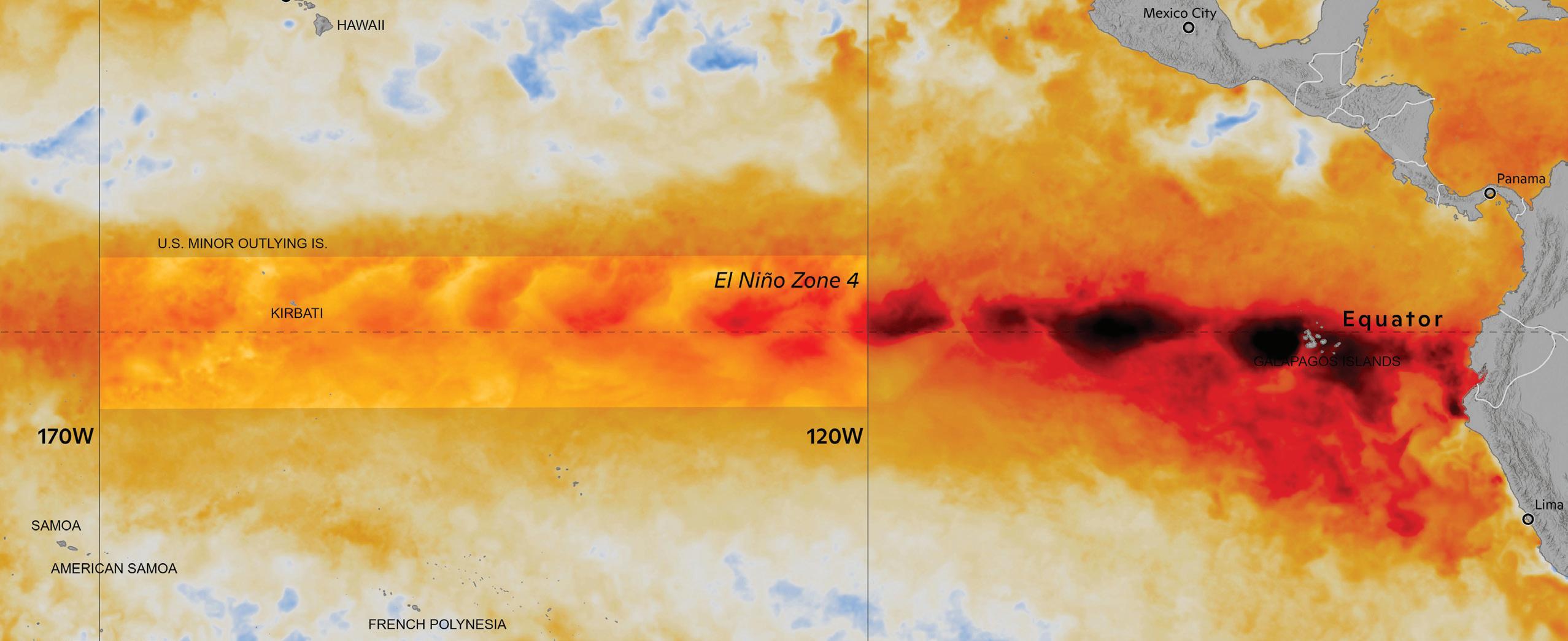
Summer 2024 Climate Science for Change 14
El Niño phenomenon can be seen in sea surface temperature patterns in the Pacific Ocean. / map by Greg Fiske Graphic by Christina Shintani
temperature records. Zobel says it’s typical for the year following an El Niño peak to maintain high temperatures.
“Because the ocean spent a good amount of the year last year warmer than average, that energy is typically dispersed throughout the globe in the following year,” says Zobel. “So even though the tropical Pacific might return to normal, that energy is still in the system.”
However, atmospheric scientists are already seeing signs that El Niño is slowing down and flipping to its counterpart, La Niña, adding another layer of complexity to predictions for 2024.
“The 2024 hurricane season is a large concern,” says Zobel. “La Niña is a lot more conducive to tropical cyclone development. If we combine above average numbers with the amount of energy that storms have to feed on, it’ll be a shock to the system.”
What does this mean for 1.5?
In the discussions around 2023’s temperatures, one number dominates the conversation: 1.5 degrees C. This is the amount of warming countries around the world agreed to try to avoid surpassing, in accordance with the United Nations’ 2015 Paris Climate Agreement. Estimates from Berkeley Earth say that 2023 may have been the first year spent above that threshold.
This assertion may take several years to verify—one year spent physically above 1.5 degrees of warming does not indicate the UN threshold has been permanently passed. What scientists
are looking for is a clear average trend line rising above 1.5 degrees C without coming back down, and for that you need several years of data. That, regrettably, creates a lag time between climate impacts and updating climate policy. But for many, the debate around the arbitrary 1.5 degree goal has become a distraction. Schwalm says scientists and policymakers should be focusing on urgently combating climate change whatever the numbers say.
“We are already living in a post-Paris Agreement reality,” says Schwalm. “The sooner we admit that and reimagine climate policy, the better.”
“Actual real world impacts are going to be there, whether we’re at 1.48 or 1.52,” says Zobel.
And Francis agrees. “There are so many indicators telling us that big changes are underfoot, that we are experiencing major climate change, but reaching 1.5 isn’t going to all of a sudden make those things worse. It’s just one more reminder we’re still on the wrong track and we’d better hurry up and do something.”
An animation of the El Niño sea surface temperature anomaly can be viewed at: https://woodwellclimate.org/2023-record-temps
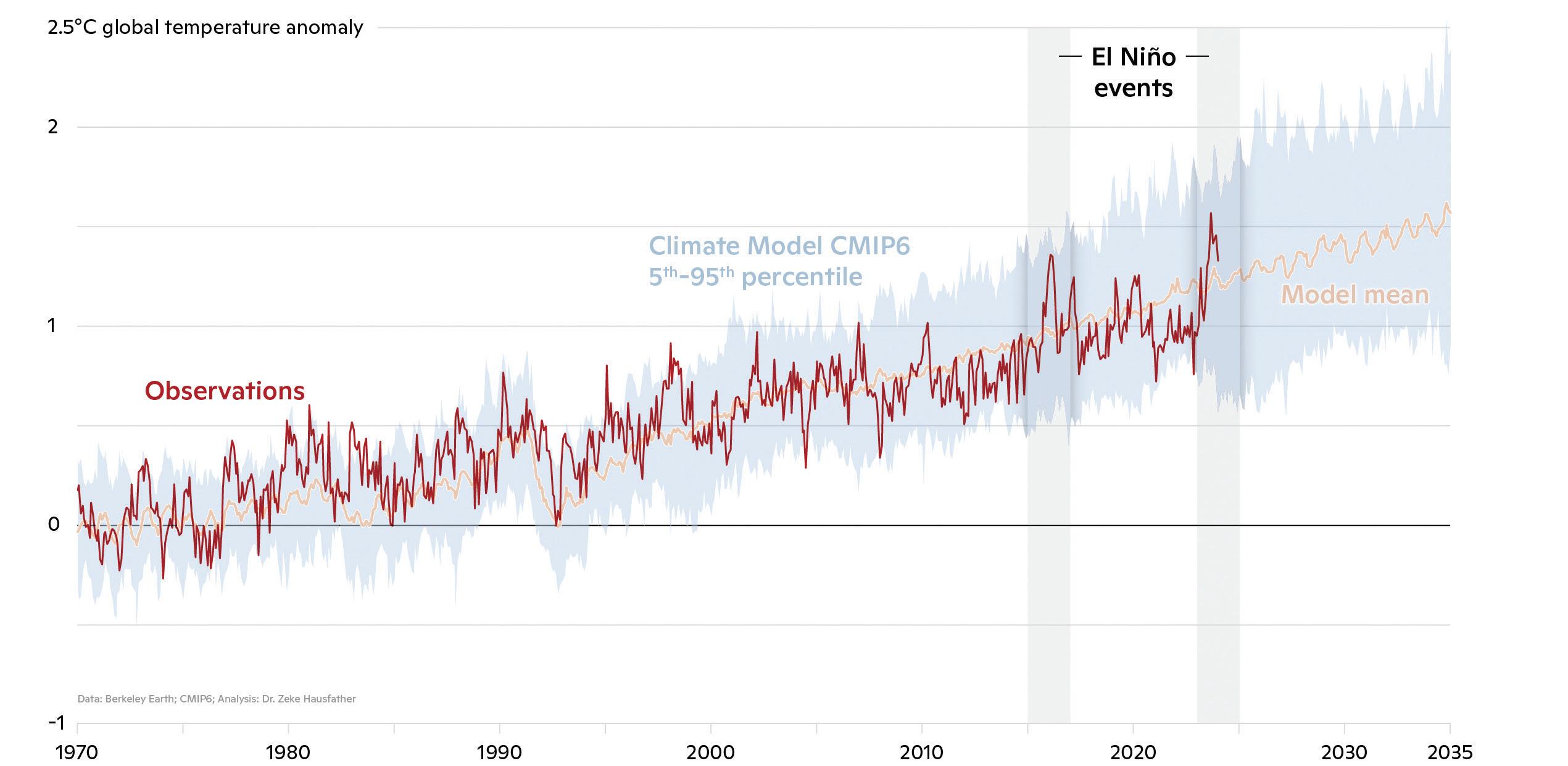
WATCH Summer 2024 15 Climate Science for Change

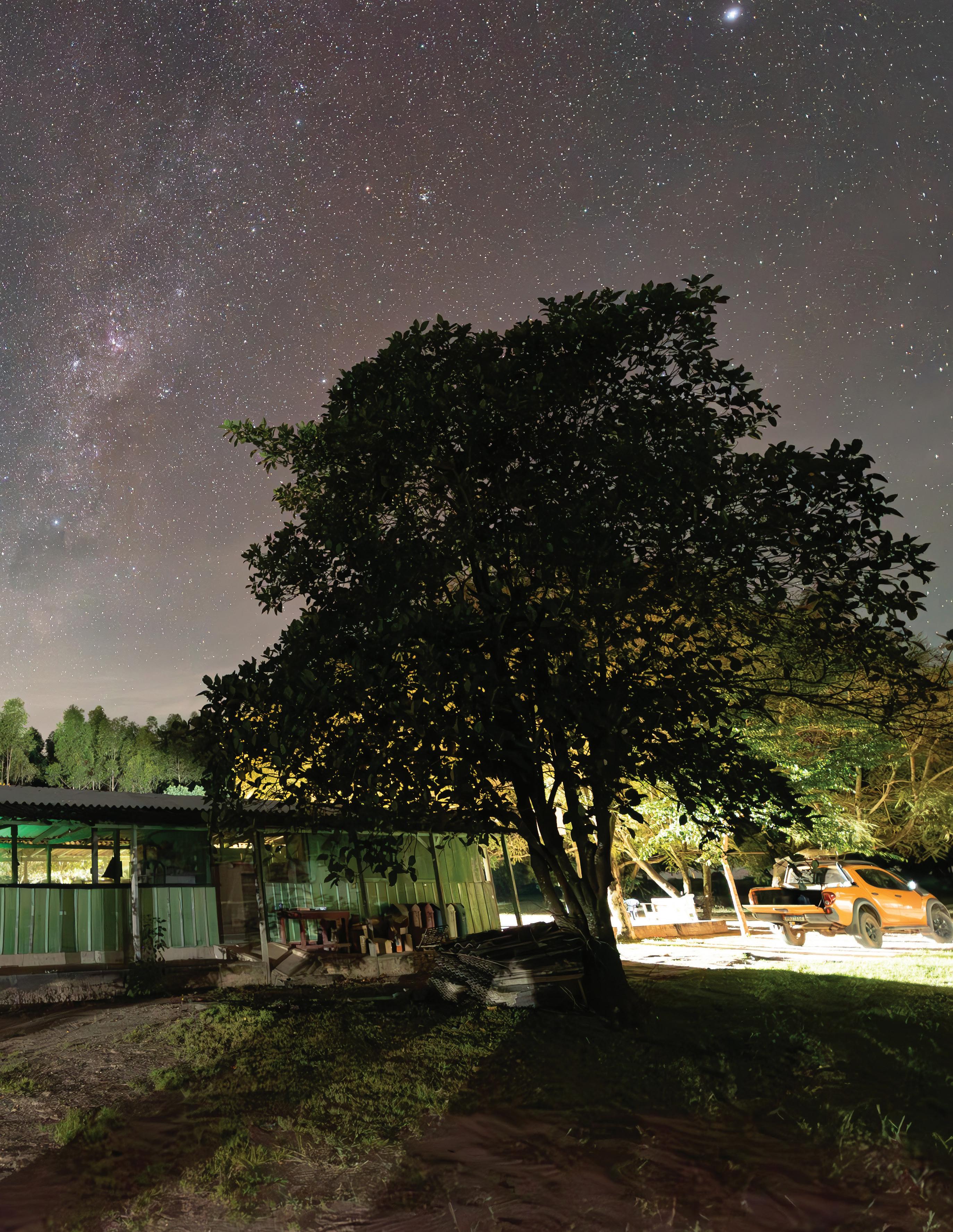
20 years at Tanguro Field Station
For two decades, this research station has stood at the southern edge of the Amazon rainforest as a perfect natural laboratory to study the changing biome
Sarah Ruiz Science Writer and Editor Mitch Korolev Photographer
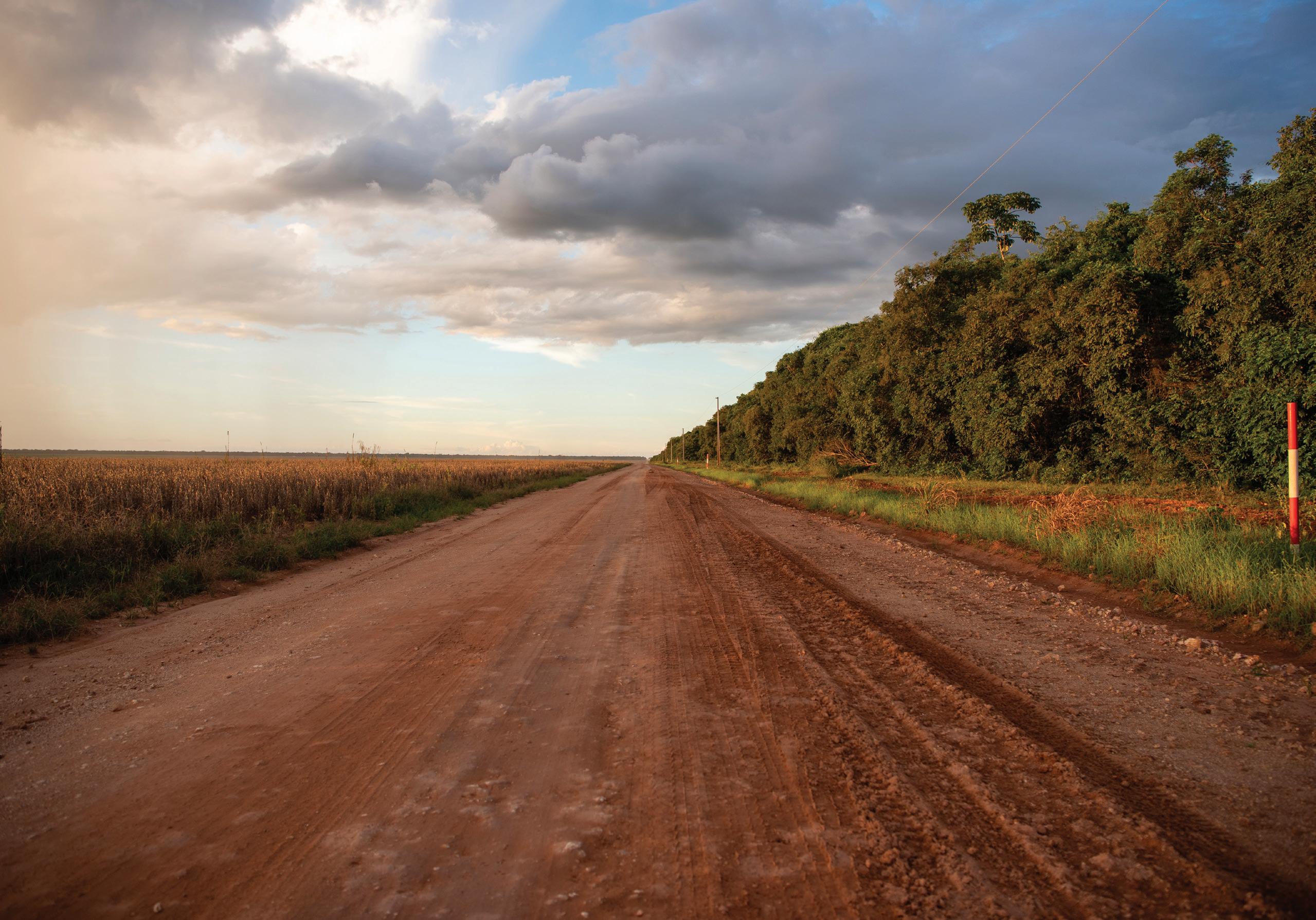
The sky opens up just as our truck leaves the last stretch of paved road. Water Program Director Dr. Marcia Macedo squints to stay focused on what she can see between wipes of the windshield. Within minutes, our path is transformed from a dirt road into a riverbed of bright orange mud, rutted from the passing of heavy trucks carrying soy off surrounding farms. Macedo swerves to dodge bumps and dips, but pretty soon there are more of them than there is flat road. We brace for the puddles, peering out windows spattered with orange spray.
It’s a Monday morning in the rainy season at the edge of the Amazon, and we’re commuting to work.
Tanguro Field Station lies about an hour’s drive from Canarana, the nearest town, located in a region of Brazil sometimes referred to as the arc of deforestation. Several decades ago, agriculture began surging into the southern reaches of the Amazon rainforest here, carving out rectangular patches of farmland from primary forest. For most of our drive, we are flanked only by mega-fields of soybean or scrubby cattle pastures.
Macedo, who has been conducting research at Tanguro since 2007, remembers a time when the drive could be marked by crossing a threshold from the Cerrado—Brazil’s woody savanna biome—into the Amazon. Now, clearing near the road has obscured that natural transition. Eventually though, clumps of lush green loom closer out of the rain and we know we’re nearly there.
Since its founding in 2004, Tanguro has offered researchers from around the world the opportunity to investigate big questions about how climate change and deforestation are affecting the Amazon. Macedo and her team have come to study Tanguro’s streams and reservoirs.
We pull to a stop outside the research station, hauling suitcases wrapped in plastic trash bags out of the truck bed. Research Assistant Zoë Dietrich clutches several vital electronic components to her chest, ferrying them to a screened-in porch to keep them out of the rain. Postdoctoral researcher Dr. Abra Atwood starts digging out sediment core tubes from a pile of equipment. The clouds drift off and the work day at Tanguro begins.
Summer 2024 Climate Science for Change 18
I. The founding
It was a controversial decision at the time. “The decision to set up on the Tanguro ranch almost drove a wedge through us,” recalls Tanguro founder, Dr. Daniel Nepstad. “We had a discussion that lasted two days.”
Fourteen years prior, Nepstad had established the Amazon program at Woodwell Climate (then the Woods Hole Research Center) in the state of Pará, studying the resilience of Amazon forests during long dry seasons. This work gave rise to a new research institute based in Brazil. In 1995, Nepstad co-founded the Amazon Environmental Research Institute (IPAM) in Belém to pursue policy-relevant science that could inform sustainable development in the Amazon. Woodwell Climate and IPAM began conducting simulated drought experiments and found that the rainforest, long thought to be immune to fire, lost that resistance during severe droughts. To investigate the implications of this, Nepstad realized, they needed a new experiment somewhere at the edge of the Amazon, where it’s drier year-round.
Nepstad had been spending more and more time in the state of Mato Grosso, fascinated by the expansion of soybean cultivation into the Amazon there. During his search for a new study site, Grupo Amaggi reached out with a remarkable invitation.
Grupo Amaggi was, at the time, the largest soy producer in the world, and soy was rapidly becoming environmental enemy number one, as hundreds of thousands of acres of forests fell to expand its cultivation.
the forests on their newly acquired Tanguro property—an amalgamation of previously-cleared cattle ranches they were in the process of converting to soy fields.
The hope was that the research would demonstrate to the world what was really happening in these massive soy farms in the Amazon, providing data that could contribute to conversations around sustainable soy.
“Twenty years ago there were lots of discussions about environmental preservation and agriculture,” says Grupo Amaggi’s ESG, Communications and Compliance Director, Juliana de Lavor Lopes. “Could those two create a symbiosis? I think we knew [they] could work together, but could we prove that?”

“But Grupo Amaggi, a Brazilian company, wanted to get out in front of the issue,” says Nepstad. The prospect of losing a major market in Europe raised questions about the best way forward. In 2002 they set up the first system for tracing the forest practices of the farmers who sold them soy. And in 2004 they extended an invitation to Nepstad to study
For Nepstad, the invitation was also the perfect opportunity to run a controlled fire experiment in an ideal location. After much debate, IPAM decided to accept.
“There were a lot of folks worried that this would ruin our reputation, undermine our credibility with grassroots organizations—a lot of NGOs felt like we were selling out,” says Nepstad.
“Some people accused us of being bought off by Grupo Amaggi.”
But Nepstad was very clear on the terms of the partnership. They would accept no money from the company other than what Grupo Amaggi invested in the buildings on the research station campus. And they would only support the farm’s activities as far as the science allowed. The research would accurately report the impacts of agriculture on the forest, with no restrictions on publication.
So in 2004, barely funded, but accompanied by a dedicated team of field technicians and researchers from the drought experiments in Pará—some of whom are still employed at the field station today—Woodwell and IPAM set up camp at Tanguro.
Night sky over Tanguro Field Station buildings.
A long, straight road into the horizon between fields and forest.
Tanguro location map by Christina Shintani.
Summer 2024 19 Climate Science for Change
II. Life at the station
Muddy boots start lining up outside the door to the cafeteria at 11:50am. Dona Lúcia sets lunch out promptly at noon.
Maria Lúcia Pinheiro Nascimento has run the kitchen at Tanguro for over 16 years, cooking filling meals for hungry scientists and field technicians three times a day. Lunch and dinner usually involve some slow-cooked or grilled meat, rice, beans, and a fresh salad or roasted vegetables. Today there’s abóbora, a green-skinned pumpkin, and leftover sausage and brisket from last night’s churrasco. Breakfast is a lighter affair—pão de queijo, eggs, fresh bread, fruit, and coffee—set out and scarfed down before work starts at 7 am.
Many of the technicians who live and work here five days a week say Tanguro is like a second home, their peers a second family. For Dona Lúcia, as she’s called by staff and visitors alike, cooking for the research station isn’t just like cooking for family. It is cooking for family. Her husband, Sebastião Nascimento, known as “Seu Bate,” was one of the original field technicians working on the drought experiment in Pará. He flew down to join the crew at Tanguro a year after it was founded and brought his family down a year later, including his son, Ebis Pinheiro de Nascimento, who also joined as a field technician. A third technician from Pará, Raimundo Mota Quintino, nicknamed “Santarém,” joined the family when he married Dona Lúcia’s daughter.
“I’m with my family,” she says. “It gives me joy.”
Related or not, the team at Tanguro works together like a family. Cooperation and respect are essential in a place as remote and disconnected (wifi only extends 60 feet from the cafeteria building) as Tanguro.


“We joke that it’s like Big Brother,” says Field Manager Darlisson Nunes da Costa. “But we are really united and we respect each other. That’s a wonderful environment to work in.”
It can also be a physically challenging environment, with long days in the heat and humidity, navigating safety concerns in a forest full of snakes and jaguars, territorial wild pigs and terrain that could easily twist an ankle. All the while ensuring the scientists get the data they need.
Every field technician has to be adaptable and multi-talented, because aside from meal times there is no day-to-day routine. Your morning might involve slashing vines to find a path to a hidden stream, selected from satellite imagery as a sampling location. The afternoon could be spent troubleshooting errors at one of the carbon-monitoring towers.
“We can’t say we have a fixed job,” says Seu Bate. “We do a bit of everything.”
All the same, the technicians have each developed their specialties over the decades. Santarém still uses waterman skills from his previous job as a fishing guide in the port city in Pará that gave him his nickname. He takes the canoe out on the reservoirs often, helping researchers pull sediment cores. Seu Bate can build whatever you need—whether it’s the aluminum base for a floating methane-monitoring chamber, or a custom collar to hold unwieldy soil core tubes while you sample them—just give him 20 minutes and some power tools. Nunes da Costa keeps the team’s field activities organized each week and can effortlessly cut a clear path through the forest. Ebis enjoys data collection, especially when it involves
Summer 2024 Climate Science for Change 20

sampling the water or fishes in Tanguro’s waterways. For the station’s Scientific Projects Coordinator, Dr. Leonardo Maracahipes-Santos, climbing the 118-foot carbon tower is just like walking.
Outsider visits to Tanguro fluctuate. Sometimes weeks pass with only the field techs in residence, and sometimes the station’s small cabin-style houses and cheerful cafeteria are crawling with guests.
This spring has already been a busy one. Maracahipes-Santos handles day-to-day operations and organizes the rotating cast of visitors. In a few short weeks, he went from touring a crew of Brazilian journalists around the study sites, to working with collaborators from the Max Planck institute on routine maintenance to the carbon towers, to coordinating conversations between visiting researchers and Grupo Amaggi representatives about removing several dams on the property.
And even during slow weeks, there is plenty of science left to do—collecting samples for ongoing studies, running data analyses, checking on equipment. A day off is hard to come by at Tanguro, but at least it’s never boring.
“It’s very interesting, because we are part of a grand thing, which is to set up experiments in the field together with scientists,” says Nunes da Costa. “And we feel a little bit like scientists, because this whole business all starts on the ground. We can start from a piece of wood placed on the ground, and get all the way up to a scientific article. I feel very proud. Not only of me, but of the whole team.”


For her part, Dona Lúcia takes great pride in feeding the science at Tanguro.
“I’m very proud to be in a company like this, today,” says Dona Lúcia. “Nowadays, to work in a company like this, you need a degree, and I don’t have one. I don’t have a culinary degree. I don’t have any degree. But I learn every day.”
Drs. Abra Atwood and Leonardo Maracahipes-Santos share a lighthearted moment while collecting water data.
Dr. Mike Coe sits for an interview.
Dr. Marcia Macedo and Darlisson Nunes da Costa dig into a hearty lunch prepared by Maria Lúcia Pinheiro Nascimento.
Raimundo Mota Quintino (Santarém) in the forest and Sebastião Nascimento (Seu Bate) at the workshop table.
Summer 2024 21 Climate Science for Change
III. A natural laboratory
Field work wraps up at 4 pm, leaving Macedo, Atwood, Nunes da Costa, and me sweaty and exhausted from an afternoon spent trudging through uneven wetlands to find stream channels. Atwood was dropping temperature loggers every 500 meters above and below reservoirs. She’s interested in the impacts these small water bodies have on the watershed, and how far downstream those impacts extend. But Amazonian streams often twist through impassable segments of marsh, so finding the sample sites requires vigorous hiking and a good machete.
After our hike, we rendezvous with the group of visiting journalists at the Darro Reservoir. One of the largest reservoirs at Tanguro, the Darro provides water to the research station for showers and cleaning. On especially hot days, it also makes a great swimming hole.

The water is warm—warmer than nearby streams, Atwood’s temperature data has confirmed—but still cooler than the muggy air. It’s also glassy clear. Our feet are visible treading the band of colder water down below. Billowing white reflections form on the surface, a perfect mirror of the clouds above.
Water is everything in the Amazon. It’s what makes the lush forests possible. It’s what connects a soy farm in Mato Grosso to estuaries at the yawing mouth of the Amazon River. And it’s what connects this region to the global climate. The clouds clustering above Darro grow heavier and darker with rain while we swim. Although much of that rain will fall back to Earth here, a large portion of it gets pushed out from the tropics to fall in other places.
“Water does two things,” says Woodwell Tropics Program Director Dr. Mike Coe. “One, it’s rainfall somewhere else. Two, water is energy. It takes a huge amount of energy to evaporate water and that energy gets released somewhere else when it rains. So the energy from the sun that falls here gets transported around the world. That’s huge. That drives climate.”
Which means that, through water, changes here have the potential to cause major changes across the globe. Tanguro’s location in a region of the Amazon that underwent intense deforestation for agriculture just a few decades ago makes it an ideal place to study that cause and effect.
“Once you remove forests from the landscape, you change some things fundamentally that you can’t really undo,” says Macedo. “You change the amount of water in streams, you change the rooting depth of the plants on the landscape, you change the entire hydrological cycle.”
Tanguro is pretty representative of the changes experienced across the region. It’s a patchwork of natural forest, soy and cotton fields, and some planted eucalyptus groves. Some of its watersheds lie completely within the bounds of the forest, others run completely through agricultural land. Some streams have well-preserved forests along their banks, while others are in the process of restoration. Amazonian species mix with those from the Brazilian savanna. It’s becoming hotter and drier as the climate changes. For the climate scientists and ecologists at Woodwell and IPAM, it’s the perfect natural laboratory.
As the first research project launched in that laboratory, the fire experiment garnered much fanfare.
“Grupo Amaggi had mobilized society, there were journalists and newspaper reporters and firefighters. People from the company and people from the local towns,” recalls Nepstad. It was new territory, intentionally burning the forest to learn how it changed the landscape. “It was really exciting.”
With each new year of burning, insights revealed themselves. One particularly hot, dry year, the forest burned even more than predicted. Nepstad recalled seeing flames, shin-high, still burning at 2 am the next morning. Tree mortality afterward jumped from its usual 6% up to 50%.
“That was tragic for that patch of forest,” says Macedo. “But it has yielded really important insights. Almost prescient. Just look at 2023. It was an incredibly dry year in the Amazon,
Summer 2024 Climate Science for Change 22

and all of a sudden we saw fires in the very middle of the rainforest—areas that used to be much too wet to burn can now burn during a big drought.”
With the fire experiment underway, there were still nearly 200,000 acres of land available to study, so Nepstad invited researchers like Macedo, Coe, and Dr. Paulo Brando, who worked with Nepstad in Pará, to explore what other stories Tanguro might be able to tell about the Amazon. In its 20-year history, over 180 papers have been published from research at the station, ranging in topic from hydrologic changes, to the climatic limits on productive agriculture, to the degradation of forest carbon, to the value of tapir poop for restoration. Brando attributes the station’s prolific results to the knowledge of its staff.
“Part of Tanguro’s magic is to learn from the people who have been working for 20 years in the forest. They have an intuitive sense of what is happening with these forests’ health,” says Brando.
Another unique aspect of Tanguro’s location is where it sits in relation to the larger ecosystem. The hundreds of small streams that criss-cross Tanguro form the headwaters of the Xingu River—a major tributary to the main stem of the Amazon. Tanguro is just 60 kilometers from the Xingu Indigenous Territory, through which the river of the same name runs. Any upstream disturbances to nutrients, sediments, or stream outflow have the potential to ripple down to the reserve, impacting the livelihoods of Indigenous communities within.
“The headwater streams that we’re studying here at Tanguro drain into the Xingu reserve. So, these scientific questions of how water quality is being impacted by agriculture are important to understand as a cross-boundary issue,” says Macedo. “Water connects everything.”
Late afternoon swimming in the Darro Resevoir.
Birds of all sizes, including emus, can be seen in the crop fields.
A lone tall tree stands out at the forest edge.

Summer 2024 23 Climate Science for Change
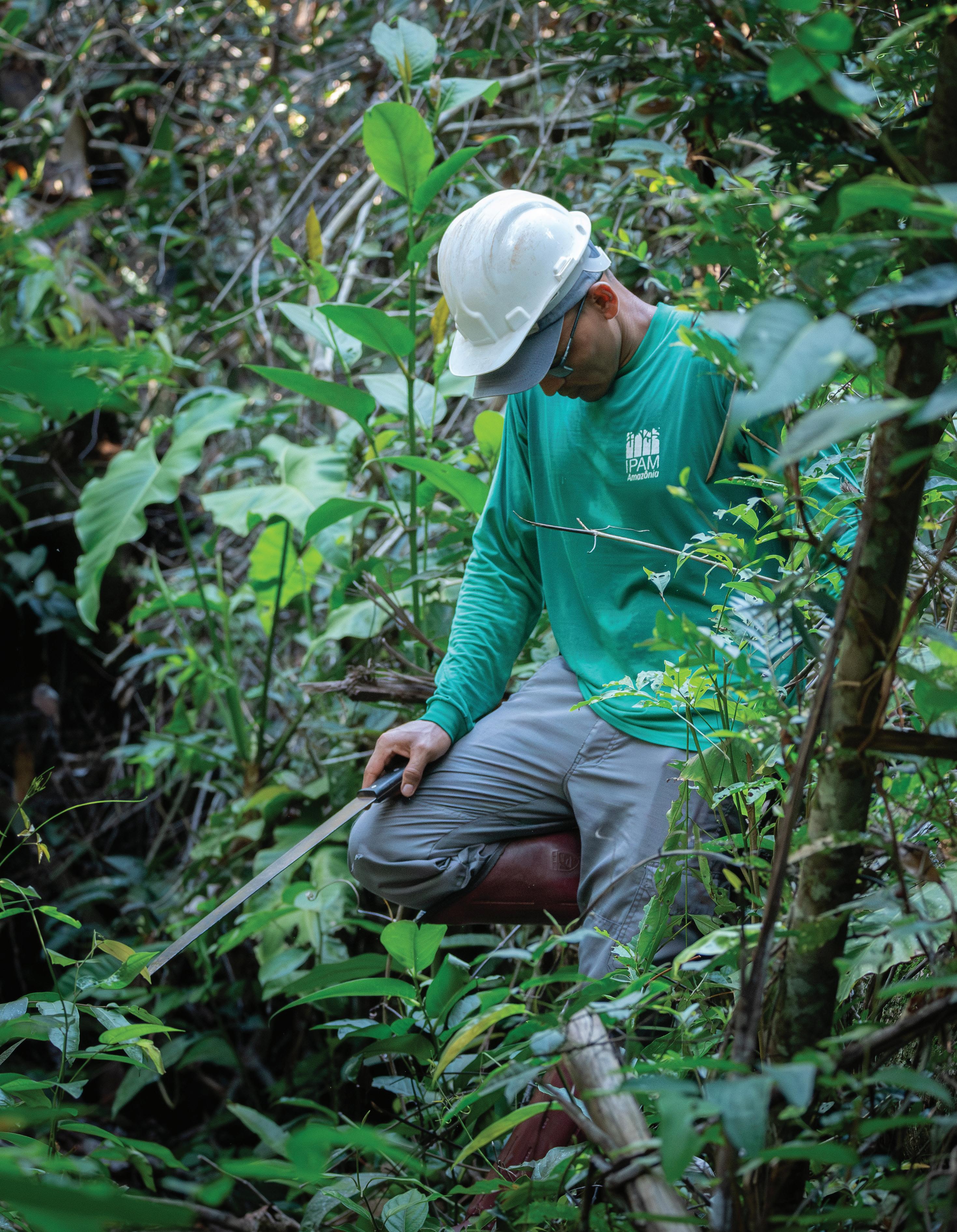
Summer 2024 Climate Science for Change 24
IV. Connecting the Community
When Tanguro General Coordinator, Dr. Ludmila Rattis, started her postdoctoral research at the field station, Canarana was a different town—small and male-dominated enough that a female environmental scientist had no hope of staying anonymous. Rattis would see her name written on bar tabs as “IPAM’s girl.” She went for runs and felt the stares.
It was a hard place to be, she recalls. “I felt watched all the time. I couldn’t do anything without bringing with me the name of an institution. And the internet connection was less than one megabyte, so Netflix was a challenge,” Rattis says. “Opening an email was a challenge.”
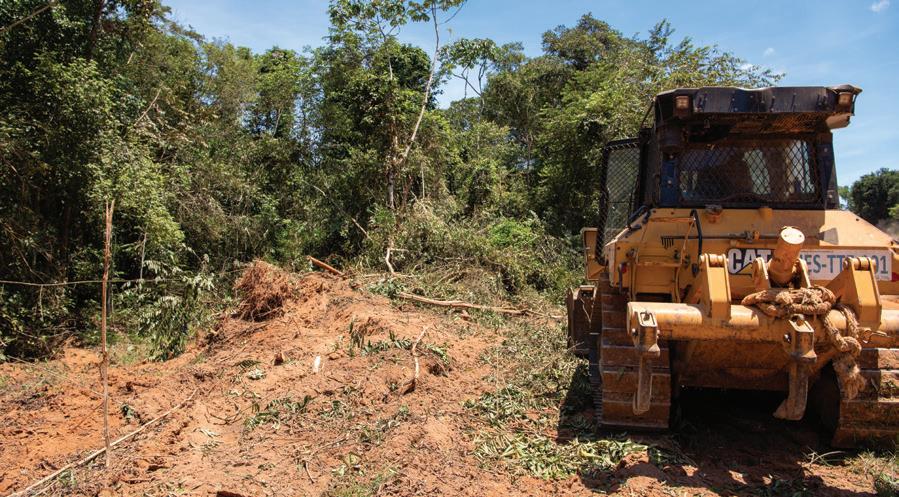
Working for an environmental non-profit in a farm town that owes its very existence to deforestation is sometimes tricky to navigate. But agriculture is woven into the DNA of Tanguro Field Station. Climate scientists may flinch to see bulldozers pressing into the undergrowth, but ultimately the proximity to agriculture here is what has yielded some of the station’s most valuable insights.
“By being here in this place for a long time, we’re able to observe changes as they happen, and say something much more confidently about what the broader impacts are on the Amazon,” says Macedo.
The partnership with Grupo Amaggi has also helped connect science to big decisions in the soy sector. In 2012, when debates over the future of Brazil’s forest code were roaring away, Nepstad was invited to join a field trip to Tanguro with the main lawmakers shaping the new code—including Senator Blairo Maggi, an owner of Grupo Amaggi. Seeing firsthand the experiments with forest restoration at the station helped demonstrate the feasibility of implementing the new protections. The forest code was revised and most of its restrictions on forest clearing are still in place today.
“It was really the science that opened these doors,” says Nepstad. Rattis’s research, in particular, has gone a long way toward strengthening partnerships with farms around the region. She spent her year in Canarana talking with farmers about their experience of climate change—rainy seasons starting later, crop yields dropping—and asking what information they
might find useful from climate models. Slowly, as she came back to them with her results, showing them rainfall and temperature predictions and keeping a dialogue open, she built a rapport that not only strengthened her relationship with the community, but helped guide future research.
“The farmers will tell you whether something looks right or not, and 90% of the time they’d say ‘Wow, can you please send me that graphic? I want to show my neighbors,’” says Rattis. One new study even began after conversations with a farm manager hinted at a connection between forests and crop production. “I said we were wondering if the crops would produce more closer to the forest, and he said, ‘That makes sense because the cotton plants are bigger closer to the forest edge.’”
Researchers at Tanguro have also built connections with residents of the nearby Xingu Indigenous reserve, partnering with villages to study the downstream impacts of recurring fires. A professor with the Federal University of the Amazon (UFRA), Dr. Divino Silvério, who conducted his doctoral research at Tanguro, has led much of this work.
“The main idea was to integrate the scientific knowledge we had at Tanguro with the traditional knowledge of the Indigenous people to better quantify the impacts of fire on species that are used by them for food, construction, and medicine,” says Silvério.
During the study, Silvério and his research team visited the Xingu reserve to discuss the research and share insights. They also provided scholarships to several Indigenous students to help in the data collection and visit Tanguro for a knowledge exchange.
“Indigenous people have been managing the forests well for centuries,” says Silvério. “But now we have climate change. It’s becoming really urgent to have these kinds of conversations, to come up with some solutions to mitigate the impacts of climate change on the livelihoods of these people.”
Rattis also believes Tanguro has a role to play as an education hub. Over the last year she has been working to create an essay prize for local students, honoring an IPAM employee who championed environmental education in the 2000s.
“The Tanguro we have today is the legacy of the many people that have worked there,” says Rattis.
Dr. Leonardo Maracahipes-Santos rests a moment from hacking a passage through the dense foliage.
A bulldozer at the border between forest and field.
25
V. What does the future look like?
Maracahipes-Santos has climbed this tower a thousand times. Today he’s climbing it once more, to anchor a back-up belay line to one of its top struts. If one of us passes out mid-climb, at least they’ll be able to lower us down gently. If all goes well, we will be climbing the 118 feet up and back under our own power, anchored to the center of the tower with a mechanism that locks like a seatbelt under sudden downward force.
The tower itself is essentially an overgrown ladder, with various gas and weather analyzers strapped to spindly poles at the top. There are three of them stationed around Tanguro to monitor the movement of carbon dioxide, water vapor, and other gasses into and out of the landscape. This particular tower is a 15-minute hike into a section of intact forest that was used as the control site during the fire experiment.
After checking and rechecking my tethers, a shout from Maracahipes-Santos, already at the top, signaled it was time to start the climb.
One hand up a rung, then the other. Feet to follow. Step, step, breathe. You’re supposed to lean back, let the harness hold you and push your weight up with your legs, but an unshakable instinct makes me pull tight to the ladder, so when I reach the top my forearms are shaking. Sweaty, breathless, flushed, but above the canopy at last. Maracahipes-Santos smiles and attaches my safety hook to one of the struts. Up here, we are taller than the trees.
From the top of the tower, you can read the history and future of this place, just by turning your head. Forest stretches to the horizon in one direction, an unbroken mosaic of deep green. In another, you can see massive rectangles of red dirt and uniform carpets of pale green soy cut into the landscape. Somewhere hidden behind a copse of planted eucalyptus are the corrugated metal roofs of the research station. Rain is falling on the horizon.
Not too many decades ago, this was all forest. Just another impossibly thick cluster of living organisms breathing and dying and growing anew in one of the most densely biodiverse ecosystems on the planet. Now, the vigilant scientific instruments whizzing away up here document its decline.
Research at Tanguro is driven by one big question: “What is the future of the Amazon?” But the answer to that question

will depend—on scientists continuing to come to Tanguro to understand how this ecosystem is changing, on the field technicians making it possible to conduct science in the forest safely, on farmers taking pride in caring for the forests that stand on their land, on government officials building policies that reflect science, and on the decisions of people thousands of miles away to reverse climate change.

“When you’re doing research on this forest, you realize it is an amazingly tough system that is now being faced with tougher and tougher stresses and disturbances. So it needs help, and it needs to be given a chance, but it will continue,” says Nepstad. “And I think Tanguro has a big role to play in that.”
“My hope,” says Rattis, “is that in 20 years we won’t be dealing with deforestation anymore. ‘Remember that time when we had to convince people not to cut down the forest? I’m so glad we’re past that.’”
The past 20 years at Tanguro have done much to point the Amazon towards a more hopeful future. What will the next 20 bring? Sunset at Tanguro from the top of the 118-foot tall flux tower.
Summer 2024 27 Climate Science for Change
In my own voice: Zoë Dietrich
New to Engineering? No Problem. Research Assistant Zoë Dietrich builds her own carbon-monitoring chambers
These low-cost, floating chambers autonomously measure emissions from ponds in the Arctic and the Amazon.
“Why not float the aquatic greenhouse gas chamber on a surfboard?” Tropics Program Director Dr. Mike Coe suggested in one of our team meetings, and I could feel the gears in my brain begin turning. I started a sketch… If mounted on a surfboard, we would need a method to open the chamber, flushing it with outside air. Back in my office, I asked Google “What turns electrical energy into mechanical energy?” Google was quick to respond: “motor.” Right, thank you, Google. Next, I typed, “Motor that pushes something up.” Google replied: “linear actuator.” Three clicks later and I had ordered my first linear actuator for 35 bucks.
Three days later, that linear actuator sat expectantly on my desk. One red wire and one black wire, “12V DC” printed on its side. I turned back to Google, “How to wire a linear actuator?” Opening the first hit, I skimmed through the photos and diagrams. None of them striking my fancy, I moved on to the second hit: step-by-step instructions, clear photos, even open-source code to program my Arduino microcontroller board—nice! Within an hour, my linear actuator was extending and retracting on command, ready to be mounted in an autonomous greenhouse gas chamber.
Adding the actuator to my sketch, I popped into Senior Research Scientist Kathleen Savage’s office to hear her thoughts. Savage always has new ideas brewing, and she suggested adding a feature that would allow the chamber to function on water and on land. The chambers are the product of a Fund for Climate Solutions (FCS) grant led by Savage to quantify carbon dioxide and methane emissions from small water bodies like lakes, ponds, and reservoirs. Because there are no low-cost and auto-sampling tools available on the market, we have been developing a new instrument to measure these emissions.
DIY science
“Chamber” is a fancy word for the upside-down buckets we use to measure how fast greenhouse gasses are released from different surfaces. By resting a bucket upside-down on a patch of soil or grass or water and measuring how fast gas concentrations increase or decrease inside the bucket, we can calculate a “flux” of gas over a set area and time. Common methods of measuring fluxes require manually collecting gas samples from a chamber to be processed in a lab, or connecting the chamber to a high precision analyzer that can cost around $40,000. These methods are costly in salary time and equipment, limiting where, when, and how often people can sample—usually daytime and in accessible areas and times of the year. We need new low-cost and autonomous

Summer 2024 Climate Science for Change 28

Deployment of a chamber with the help of Raimundo
Quintino
Zoë Dietrich presents her research methodology to visiting journalists.
systems that can measure around the clock to improve carbon emissions estimates. The recent commercialization of cheaper sensors and control systems to operate them, like the Arduino microcontroller, now make these developments possible.
I’m building a new floating chamber that measures aquatic fluxes autonomously using a $15 methane sensor and a $78 carbon dioxide sensor, improving previous designs published by Dr. David Bastviken’s group at Linköping University in Sweden. Powered by a solar panel and battery, the sensors measure gas concentrations, temperature, and humidity inside the chamber every 30 seconds. The data is stored on an SD card and transmitted within 50 meters via radio. The radio transmission allows us to check that the chamber is functioning properly from the shore and to see chamber measurements in real time. When gas concentrations have increased enough to discern a flux, the linear actuator extends to open the chamber, flushing the interior with outside air before retracting to close the chamber again for another flux measurement. Calibrating the chamber with a high precision analyzer in the field shows the low-cost sensors perform well, with an accuracy of approximately 1 ppm for methane and 3 ppm for carbon dioxide.
Field deployment
I first tested chamber prototypes last July on agricultural reservoirs at the Tanguro Field Station in Brazil. At the end of our field campaign, I left one chamber deployed to see how long the electronics would last and which components might eventually fail. After helping me deploy and calibrate the chamber, field technician Raimundo “Santarém” Quintino monitored it, checking its “vital signs” via radio every few weeks. In January, he noticed the linear actuator had stopped pushing the chamber open.
/
During a follow-up field campaign in March, I brought a couple of extra linear actuators and five more chambers to deploy on additional reservoirs at Tanguro. Tanguro staff and I worked together to modify chamber components that didn’t function well in the first deployment. These modifications included swapping the materials of the floating foam bases and improving the mounting mechanisms of the linear actuator and chamber hinge. Our adjustments were informed by recommendations from a Laboratory Operations Manager at the University of Maine in Orono (Christopher London), whom I met while doing fieldwork at the nearby Howland Research Forest. Woods Hole locals, such as John Driscoll and Fred Palmer of the Woodwell Climate Facilities department, kite foiler and carpenter Tad Ryan, and employees at Eastman’s Hardware, have also offered transformative recommendations on building materials and techniques to stabilize the floating chambers.
Working hands-on with the floating chambers on the reservoirs, Santarém, Dr. Leonardo Maracahipes-Santos, Tanguro’s Scientific Projects Coordinator, and Sebastião “Seu Bate” Nascimento of Tanguro Field Station have made invaluable improvements to the chamber design and deployments. A few of their contributions include advice on safe deployment locations, monitoring and collecting data from the chambers over time, and constructing aluminum and galvanized steel components for the floating bases. They also designed a new mount for the most recent chamber addition —a bubble trap that uses an inexpensive pressure sensor to autonomously measure the volume of gas released as bubbles.
Freshwater ecosystems worldwide emit nearly half as much carbon dioxide and methane as fossil fuel combustion. On the Amazon-Cerrado frontier, where Tanguro is located, there are
Mota
(Santarém)
photos by Mitch Korolev
Summer 2024 29 Climate Science for Change


Summer 2024 Climate Science for Change 30


LAKE model utilized by Arctic Program scientists Dr. Elchin Jafarov and Andrew Mullen. The model predicts variations in carbon emissions from ponds, providing insight into processes regulating methane and carbon dioxide. By applying the LAKE model to both Arctic ponds and Amazon reservoirs, we can gain a deeper understanding of their impacts on regional greenhouse gas budgets.
“Deploying floating chambers will streamline the process of gathering aquatic data and enhance the temporal resolution of the data, which is vital for modeling and currently absent in existing datasets,” notes Jafarov.
Problem-solving and collaboration
While calibrating the low-cost sensors in our boat one March afternoon, Santarém and I noticed the linear actuator on another nearby chamber wasn’t retracting and extending as it should. Expecting another replacement was in store, we tuned into the radio and popped open the electronics case to check for “symptoms.” Blinking lights and radio silence revealed an entirely new and perplexing issue causing the malfunction.
hundreds of thousands of small agricultural reservoirs, which are important, yet overlooked, greenhouse gas sources. These artificial ponds—installed to provide drinking water for cattle, facilitate road crossings, or supply energy at the farm scale— can persist for decades, creating low-oxygen conditions that drive methane production. Monthly sampling of six reservoirs over a year by Water Program Director Dr. Marcia Macedo revealed high methane and carbon dioxide emissions, varying with season and reservoir size. But these measurements did not capture the significant variability that can occur on daily, monthly, and annual time scales, including transient “hot spots” and “hot moments” of high greenhouse gas emissions.
This lack of frequent measurements hinders climate scientists’ ability to integrate emissions at the reservoir scale in order to estimate cumulative greenhouse gas emissions at the landscape scale. The autonomous floating chambers will address that gap, enabling comprehensive carbon monitoring and modeling of the reservoirs.
From the tropics to the Arctic
Additionally, these chambers are versatile tools that can be used across different environments. Funded by a subsequent FCS grant, six new floating chambers will accompany me to the Yukon-Kuskokwim Delta, Alaska, this summer to measure greenhouse gas emissions from Arctic ponds. The chambers will supply the frequent data necessary to constrain the
Building this system from the ground up over the last year, the one constant has been mind-bending electronics puzzles that keep me up at night. As a biogeochemist by training, these problems usually require some tinkering, a dictionary, a lot of Googling, and sometimes bugging electrical engineers down the street at the Woods Hole Oceanographic Institution (Lane Abrams) and Spark Climate Solutions (Bashir Ziady), whose advice and contributions have substantially improved the chambers’ electrical designs. Each problem can usually be traced to a perfectly logical, satisfying solution, leaving me feeling wiser and excited to tackle the next one. I’ve tracked this new problem down to something potentially involving a “memory-leaking variable declaration” in my new bubble trap programming code. I might’ve fixed it with a “watchdog timer.” Both are new words for me, too. If the watchdog timer doesn’t pan out, Santarém and I will try another fix.
Designing, building, and testing these chambers has been an iterative and constantly evolving process. What works well? What doesn’t? How can we do this more simply? Using less energy? For a lower cost? How can we improve the design so that other researchers can easily build these floating chambers as well? Soon we plan to publish open-source instructions detailing how to build and troubleshoot the floating chambers—I have already sent preliminary instructions to three interested research groups. I’m lucky to collaborate with many talented people from Woods Hole to Maine and Brazil, many of whom are as new to chambers and fluxes as I am to engineering. Nevertheless, these floating chambers incorporate a brilliant flourish from each of them.
From sketch to chamber device prototype. / photos by Zoë Dietrich With assistance from Seu Bate, Zoë Dietrich constructs a chamber for deployment at Tanguro Research Station. / photo by Mitch Korolev
Summer 2024 31 Climate Science for Change
A final check and set up is done with Dr. Marcia Macedo before deployment. / photo by Mitch Korolev
Larry Huntington
Outdoorsman, philanthropist, Emeritus Director
Margaret Lin Communications Manager
The first time Dr. George Woodwell asked Larry Huntington to join the Center’s board of directors, Huntington declined. He was currently Board Chair of the World Wildlife Fund (WWF), a role Woodwell had previously held. However, Huntington remembers that Woodwell was “very persistent.”
“The day I finished my term as chairman [of WWF], George called me up and said, ‘How about now?’” Huntington laughs. “I came aboard and never looked back.”
Huntington is a long-time appreciator of the outdoors—he’s made 8 transatlantic sailing trips, completed 23 Newportto-Bermuda races, and has even climbed Mt. Everest twice. What drew him to Woodwell Climate, beyond his friendship with its founder, was the organization’s commitment to policy impact.
“I think what interested me most about George’s approach was that he recognized that pure research without a policy eventuality was a waste of time,” says Huntington. “He was interested in creating the basis for policy change from the very beginning.”
Huntington served on the Center’s board from 1994 to 2015, including terms as Chair and Treasurer, and now as Emeritus Director. He brought a deep knowledge of finance from his career at Fiduciary Trust Company International in New York City, where he served for 30 years as President and Chief Executive Officer.
Early in his time on the board, Huntington recognized the importance of sustainable funding to support the Center’s mission. He created the Huntington Endowed Fund in 1997, and also contributed significantly to the endowment of the George M. Woodwell Chair in Conservation. Having served on the boards of many nonprofit organizations, including Roosevelt Hospital, Trinity Church Wall Street, and New York Law School, Huntington is intimately familiar with a nonprofit organization’s need for long-term sustainable funding.
“An organization which has to raise money every year to pay the salaries of the scientists and the staff has to have some sense of permanence beyond the extraordinary ability of the fundraisers to do their jobs—and that means endowment,” Huntington says. An endowment “will be there forever, and throws off a reasonable percentage every year to cover the overhead of the organization… it’s critical to achieve stability.”
Huntington’s long-time support of the Center and forward-thinking generosity are inspired by his belief in Woodwell Climate’s unique ability to drive climate science for change.
“I think that most people who have thought about climate would agree that this is the overarching issue of our time,” he says. “It needs the best possible work that humans can bring to bear to deal with the problems that humans create.”
Presenting Dr. Gro Harlem Brundtland with the Huntington Environmental Award (center) 2015 Transatlantic Race (bottom) / photo courtesy of W. Stephen Lirakis

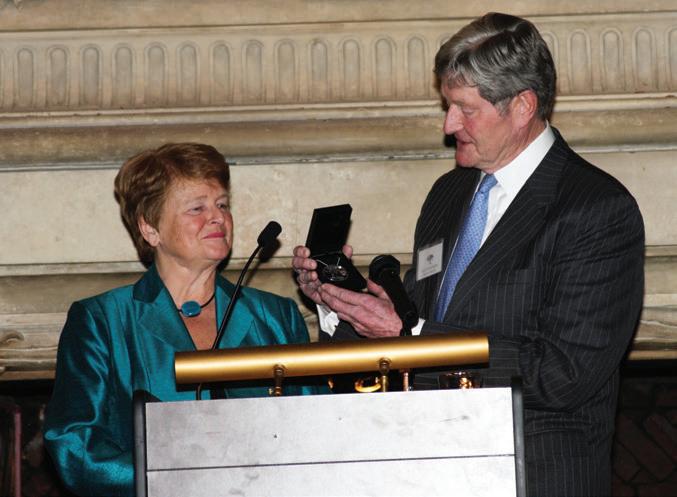

Supporter profile
Summer 2024 Climate Science for Change 32
It’s easier than ever to support climate science for change.

BECOME A CLIMATE CHAMPION
Climate Champions make an ongoing, monthly gift to support Woodwell Climate’s work, providing reliable support we can count on. It’s the greenest and most convenient way to do your part. Sign up at woodwellclimate.org/ ClimateChampion
DONATE AN OLD VEHICLE
Vehicle donations—including boats, motorcycles, and RVs—are tax deductible and support Woodwell Climate’s work. We’ll even tow it away for free, whether it runs or not. Get started at woodwellclimate.org/DonateYourCar
MULTIPLY YOUR GIFT
Many employers will match charitable contributions from their employees, retirees, and spouses. Ask your employer if they have a matching gift program.
CREATE A LASTING LEGACY
You can help protect our world for future generations by including Woodwell Climate in your will or other estate plans. Legacy gifts cost nothing today and make an incredible impact on the future. Learn more about the options available at legacy.woodwellclimate.org.
TAX-SMART WAYS TO GIVE
Donate appreciated assets like stock, recommend a gift from a Donor Advised Fund, or make a tax-free gift from your IRA. Visit legacy.woodwellclimate.org to explore your options.
For more information, please contact Chris Boudreaux, Director of Annual Giving, at cboudreaux@woodwellclimate.org.
Polaris Project’s base camp. The annual research expedition focuses on the Yukon-Kuskokwim Delta in Alaska. / photo by Greg Fiske
.
$

CLIMATE SCIENCE FOR CHANGE 149 Woods Hole Road Falmouth, MA, 02540-1644 woodwellclimate.org @woodwellclimate #climatescienceforchange

































































































